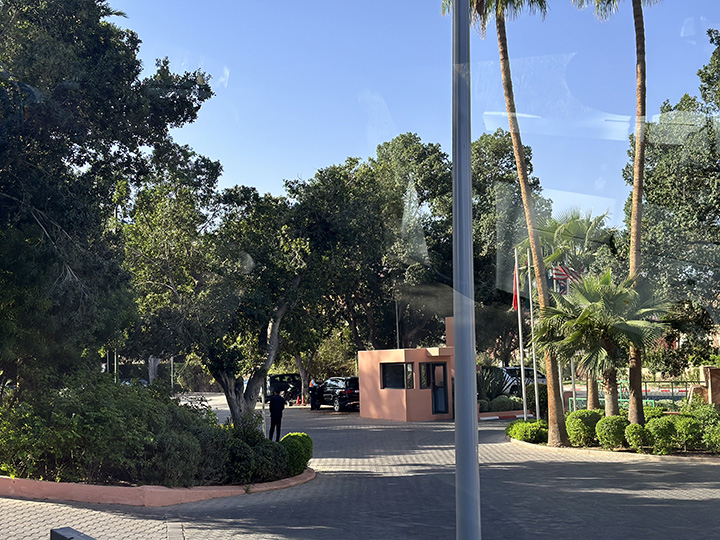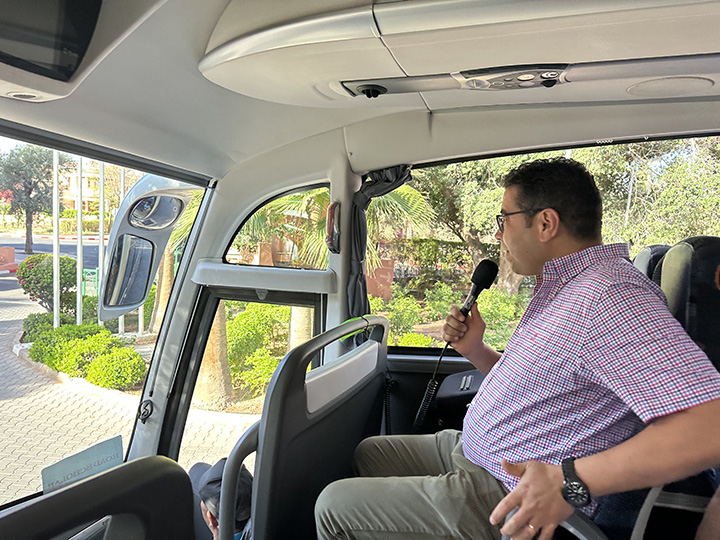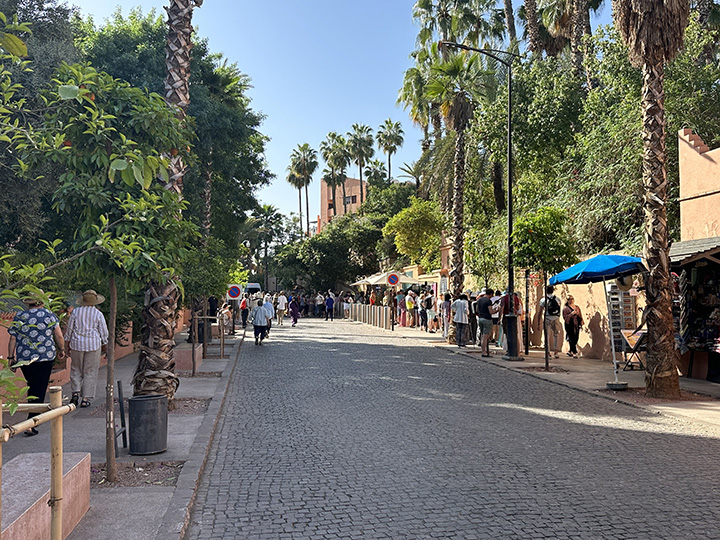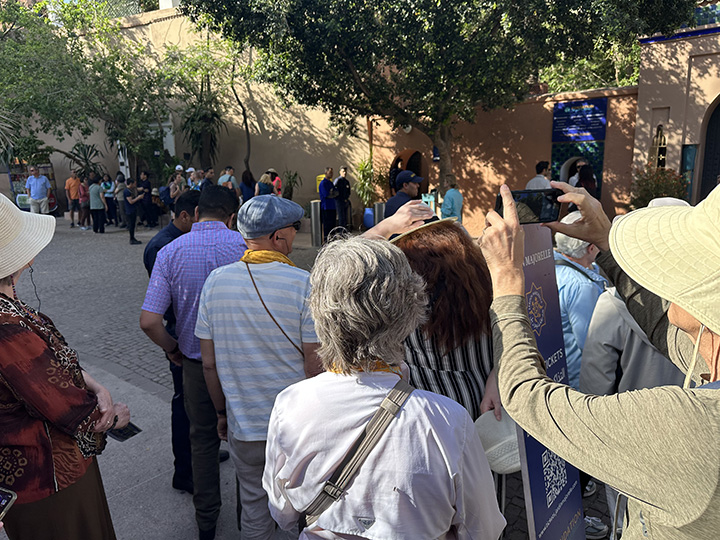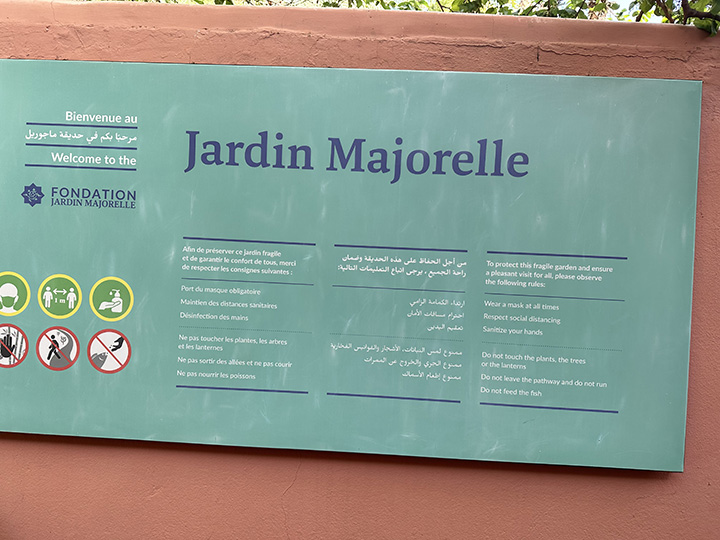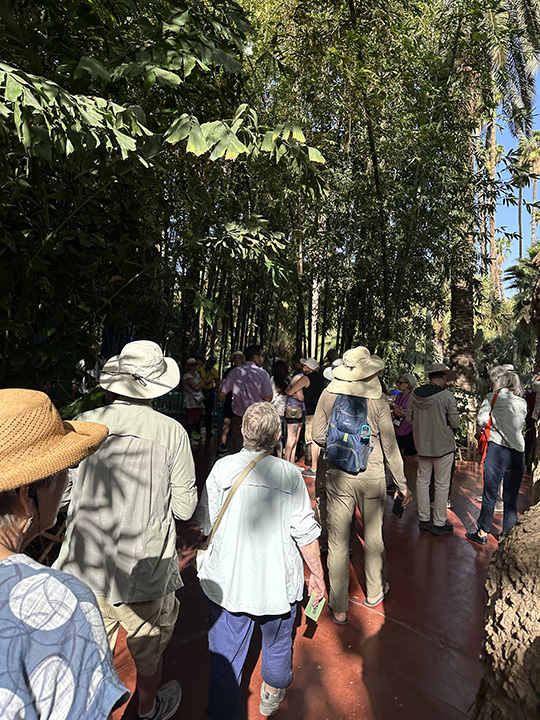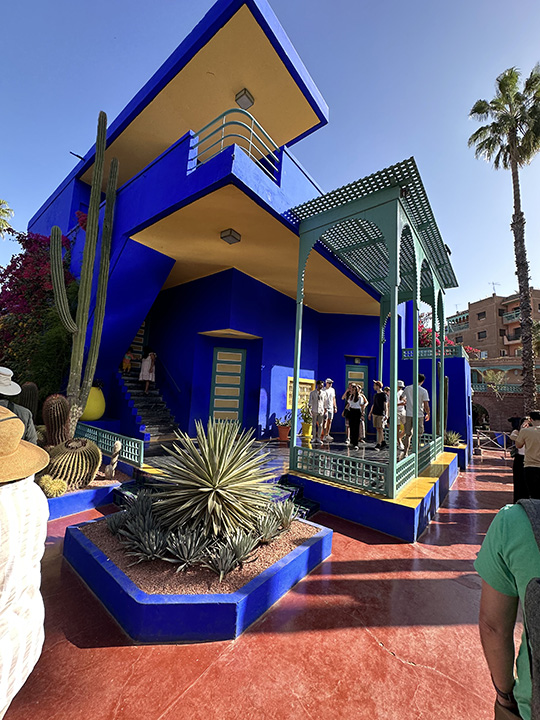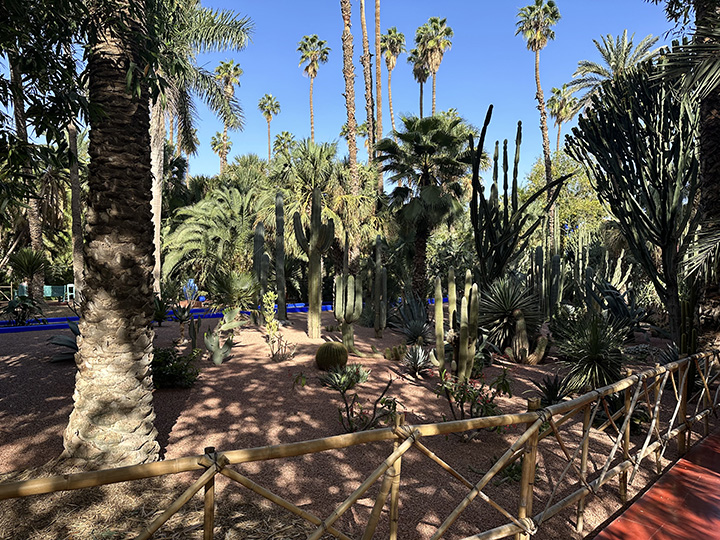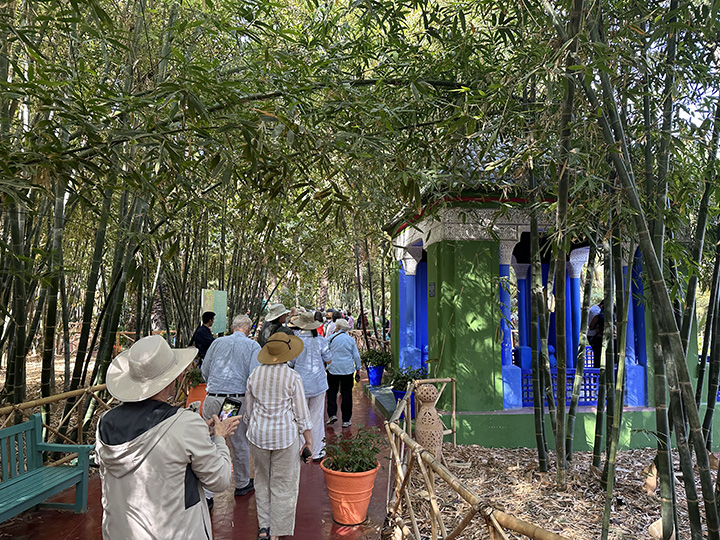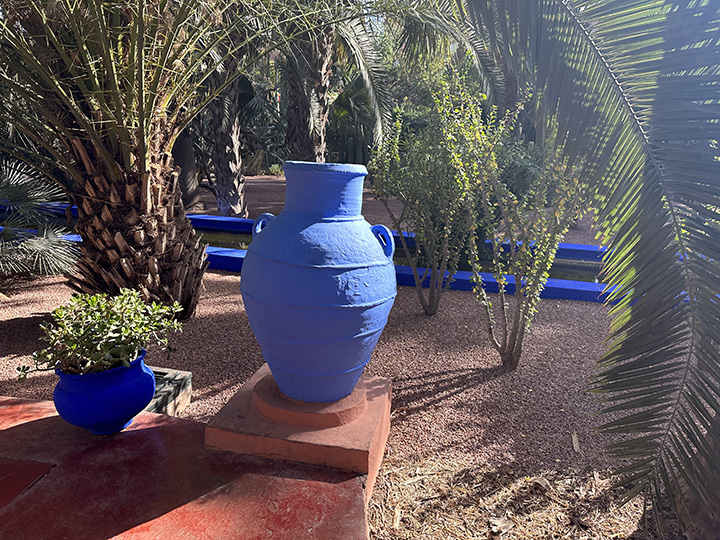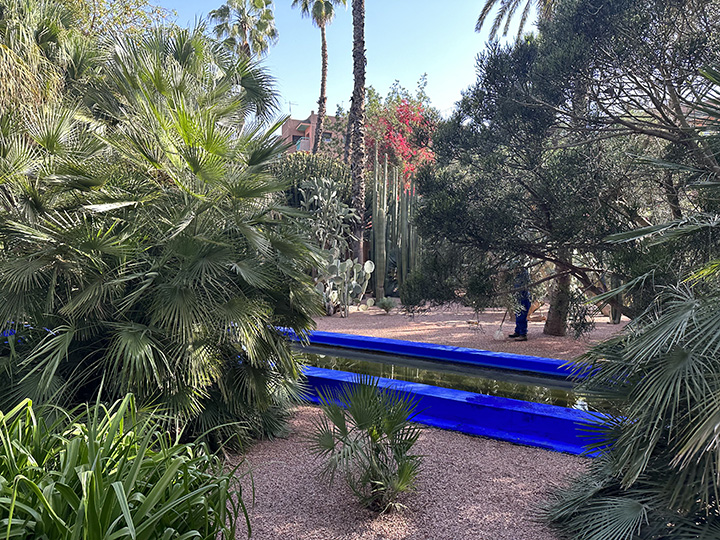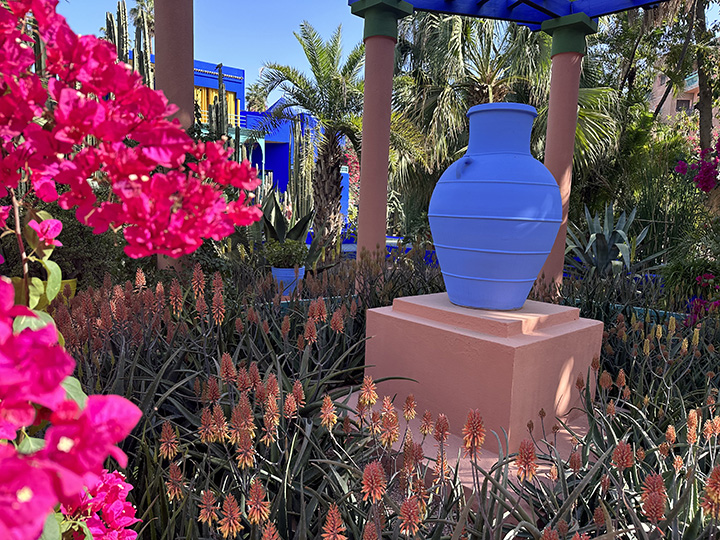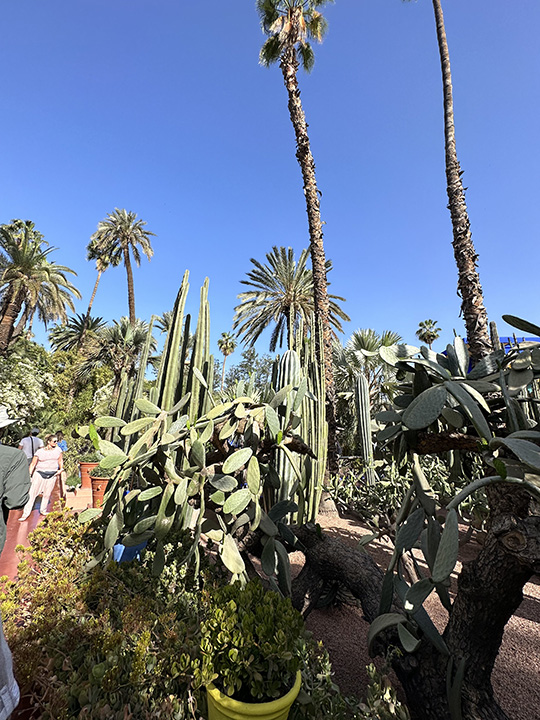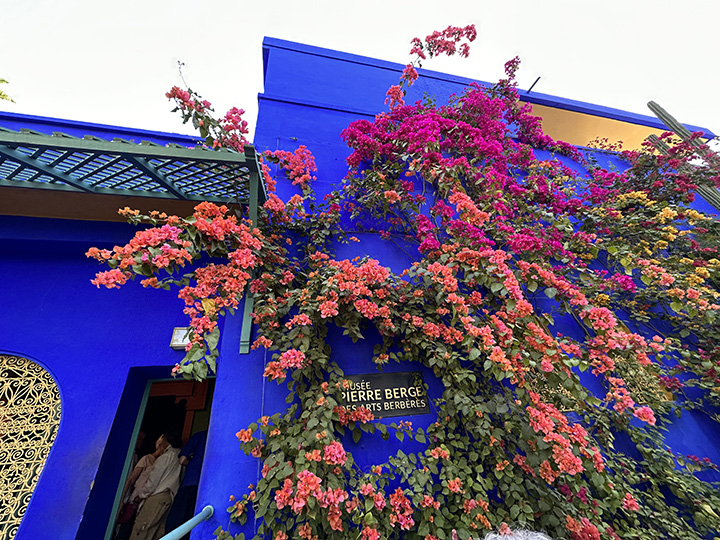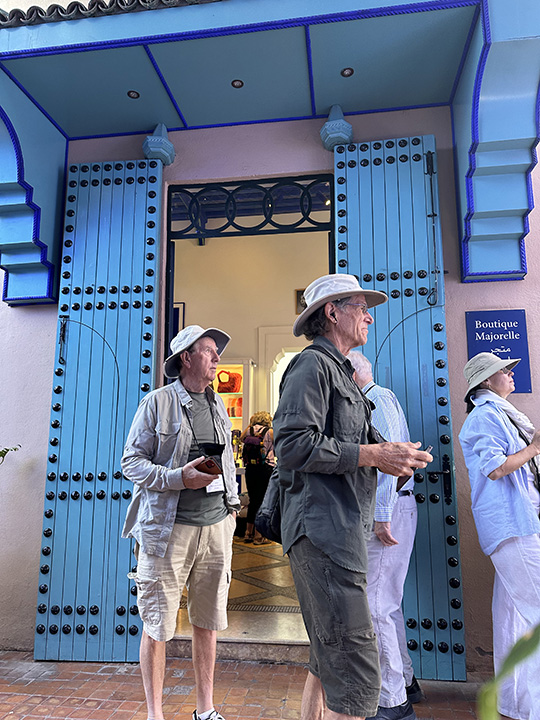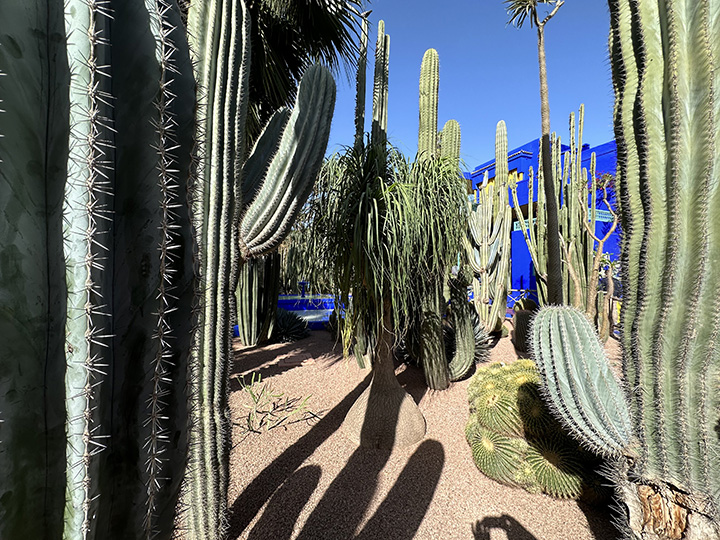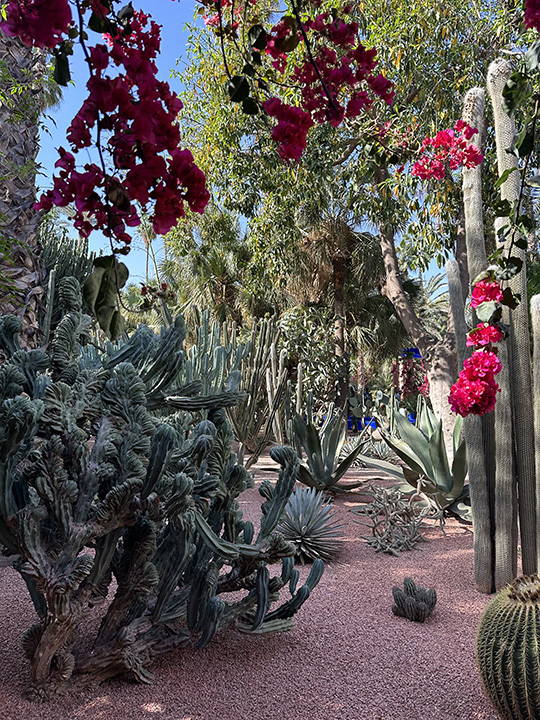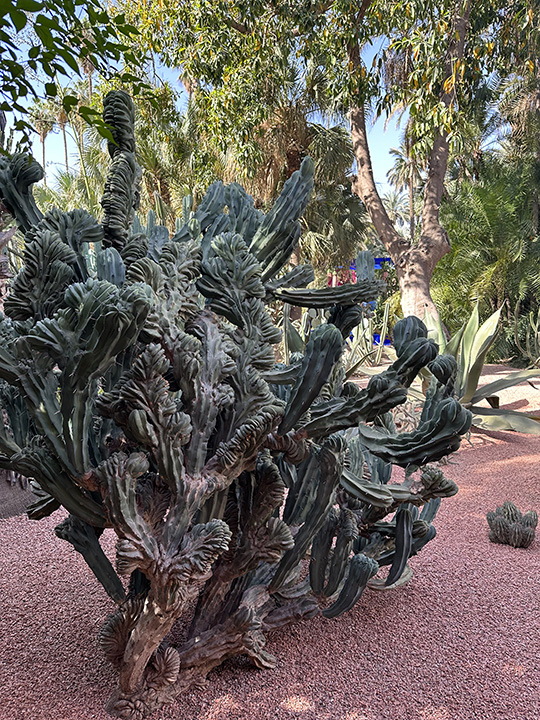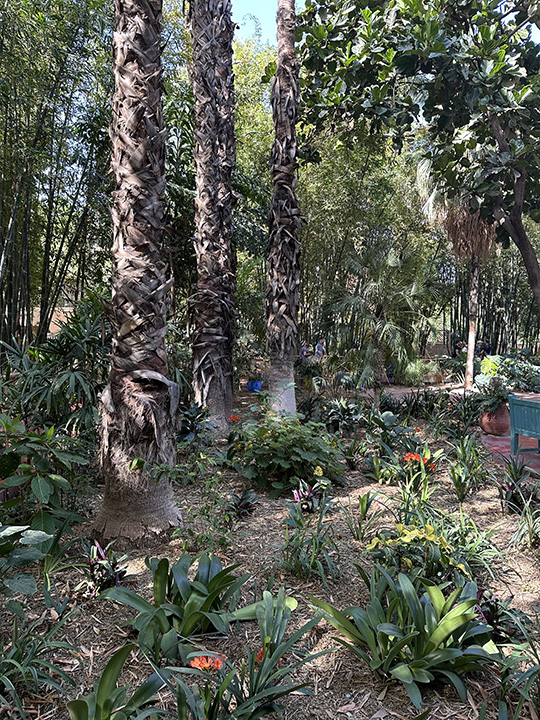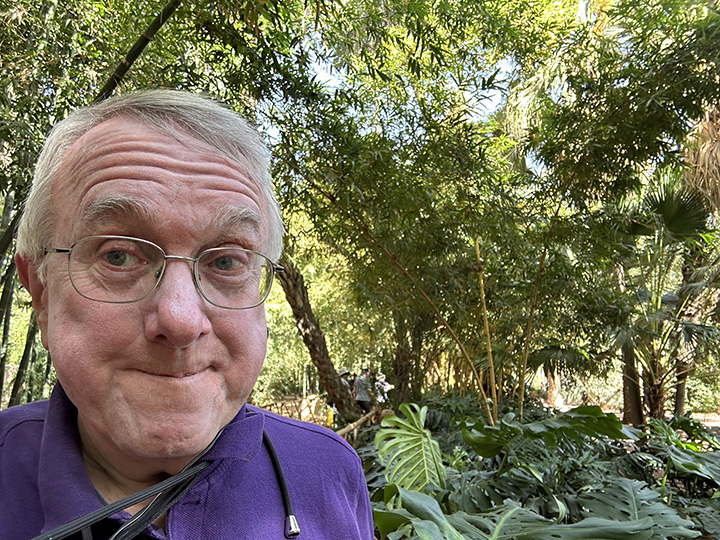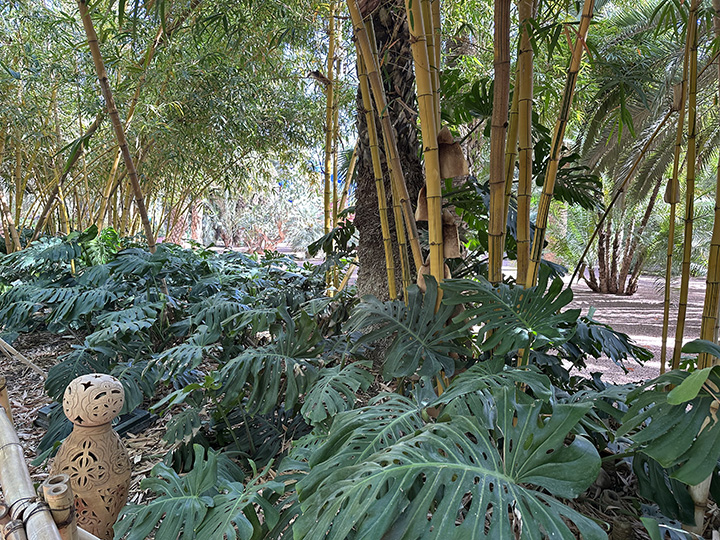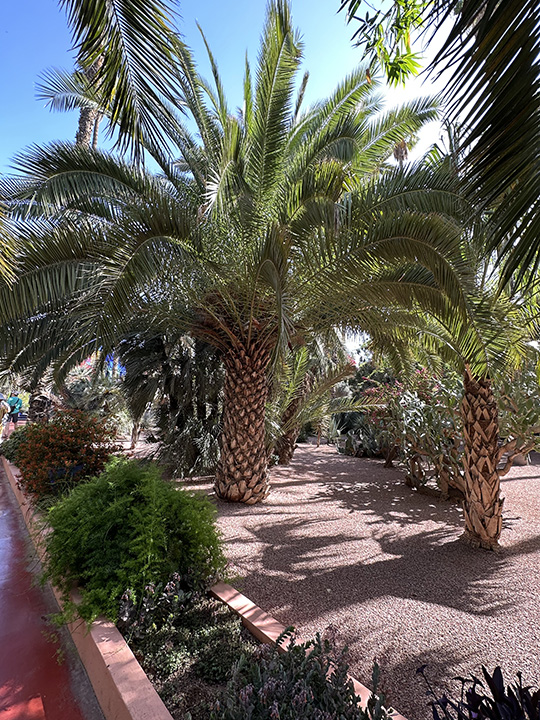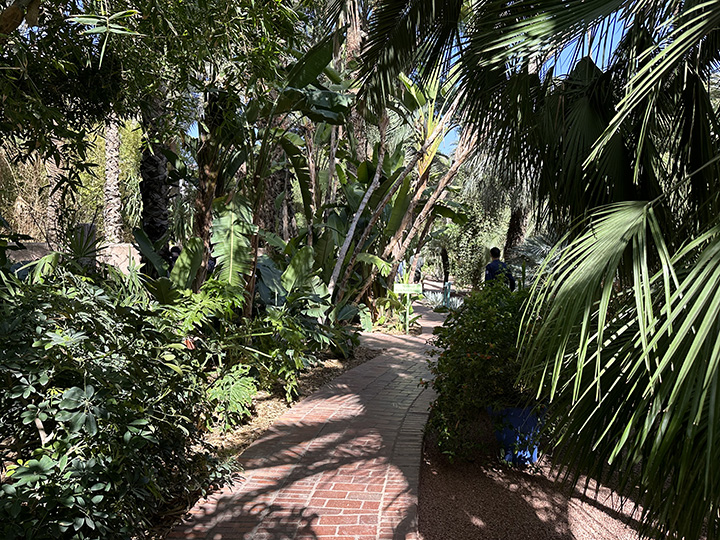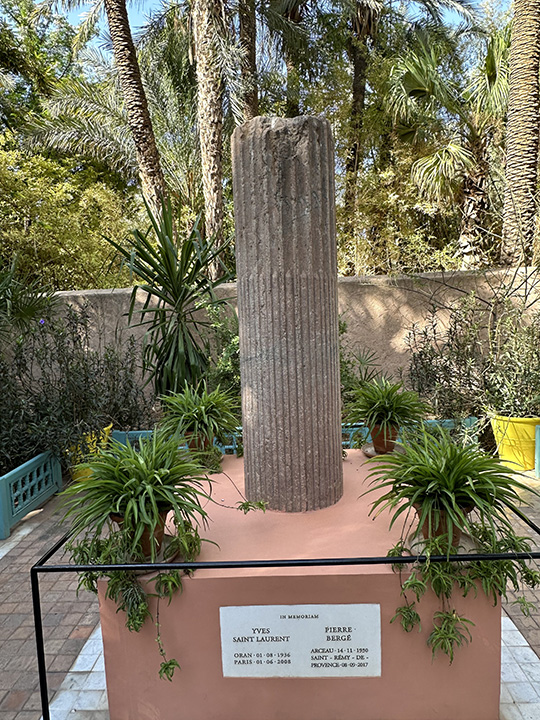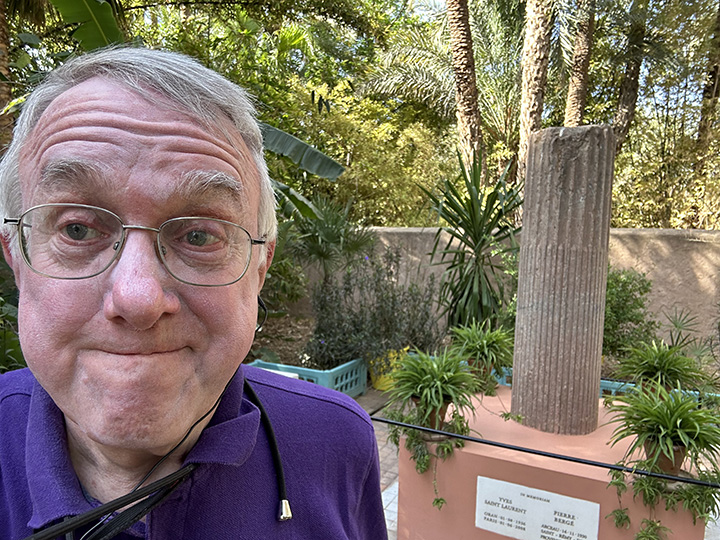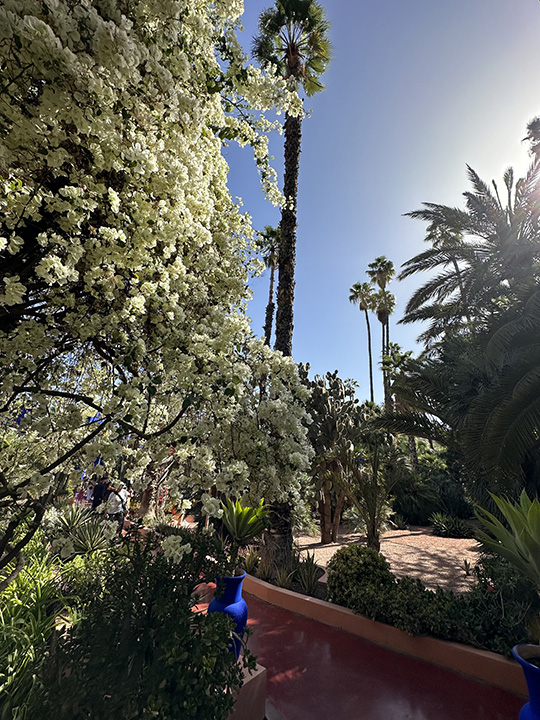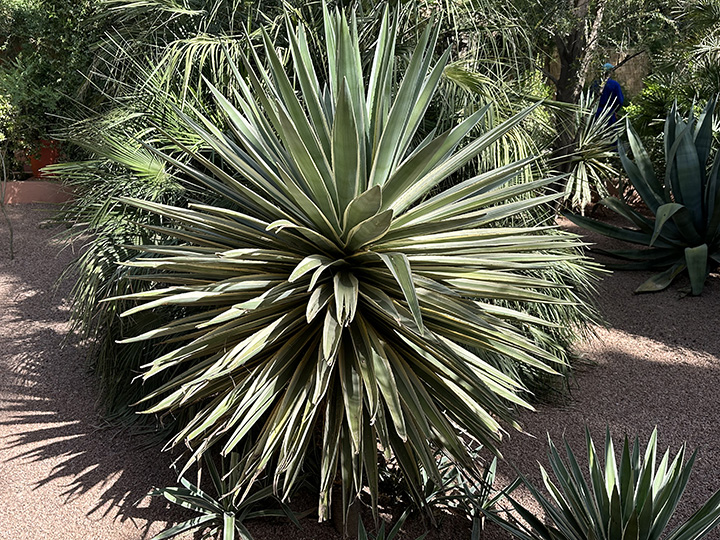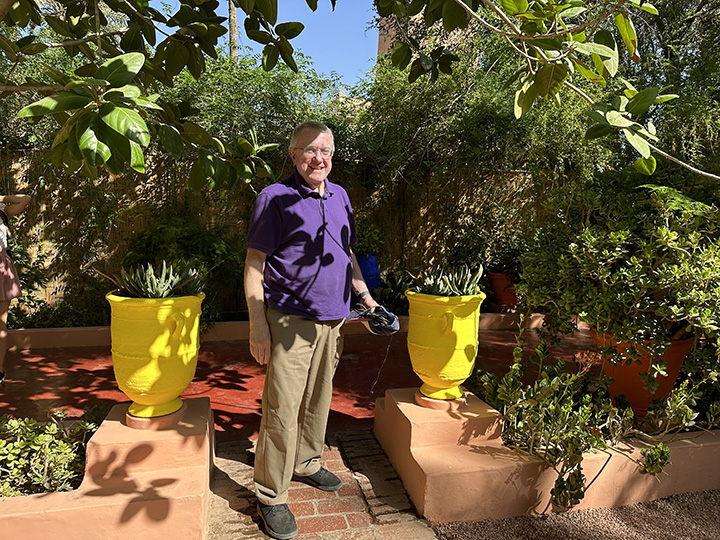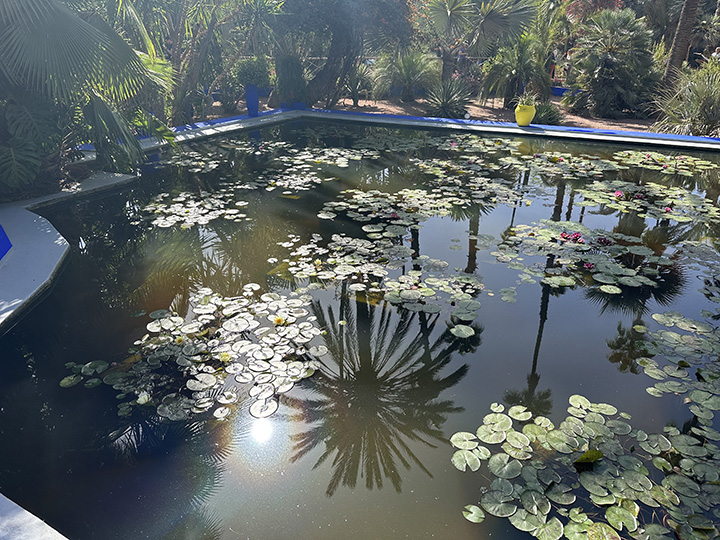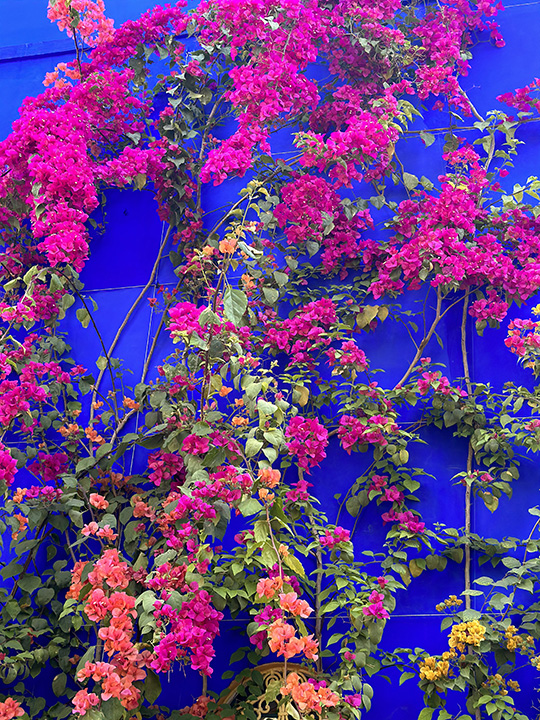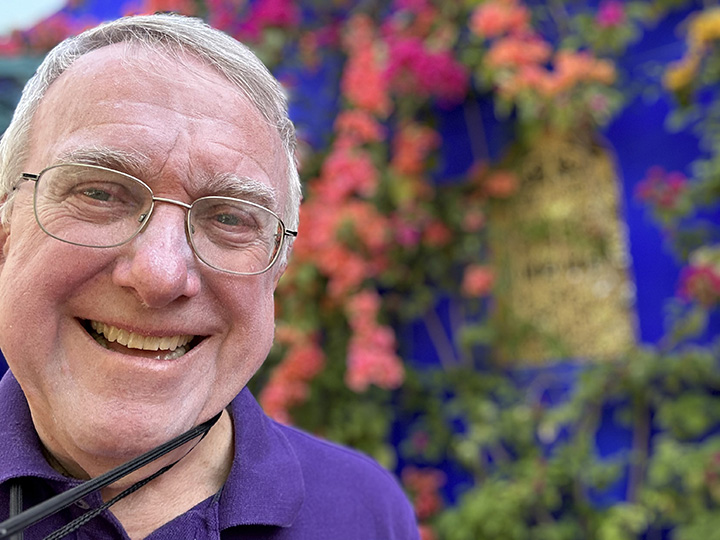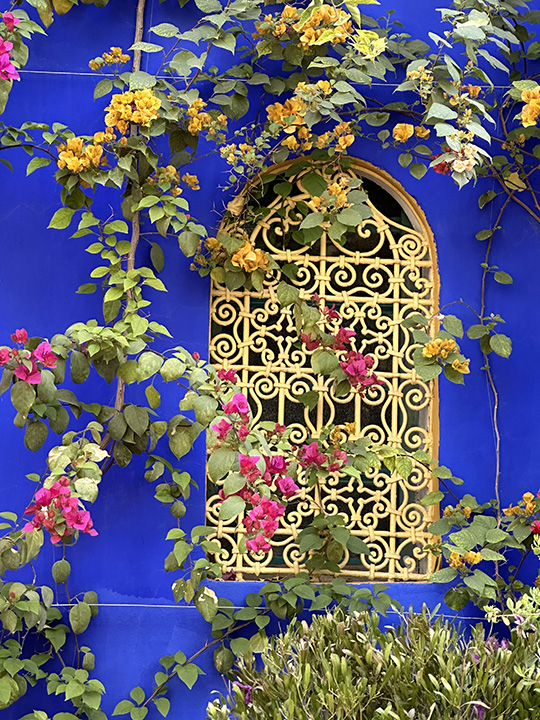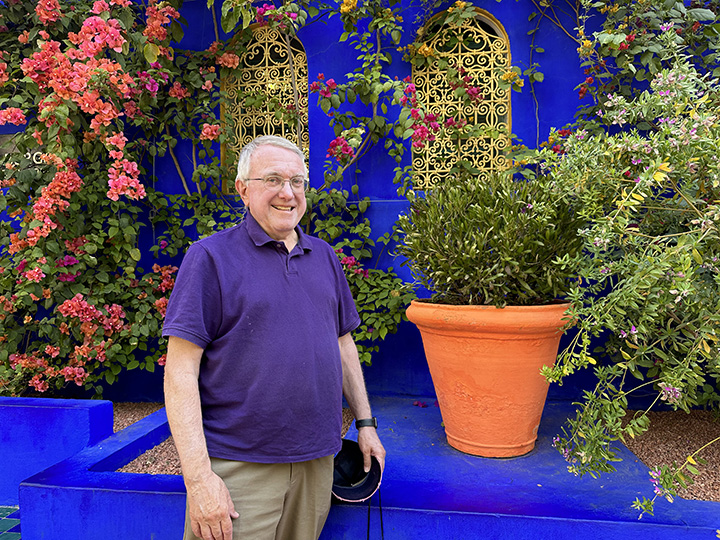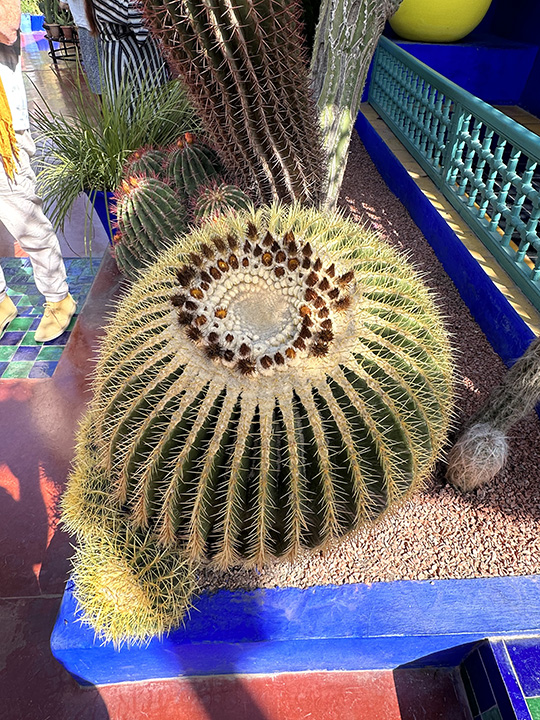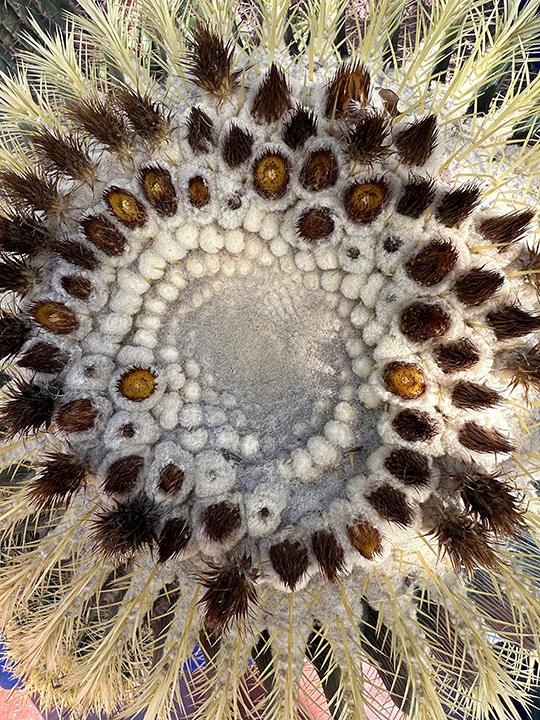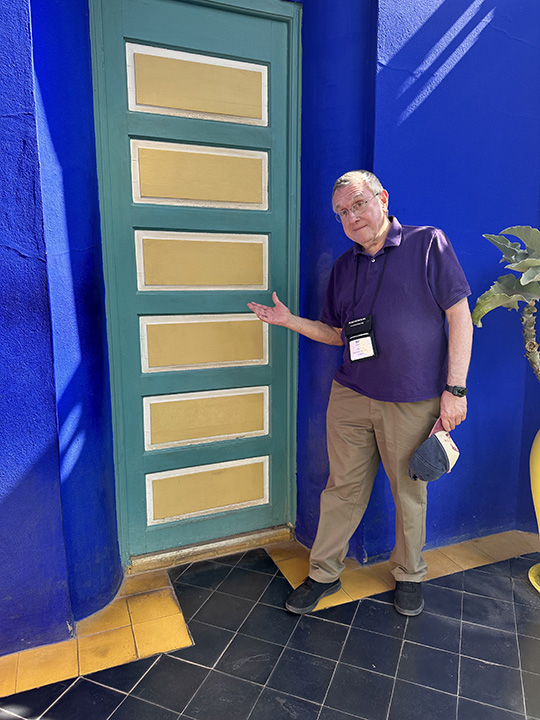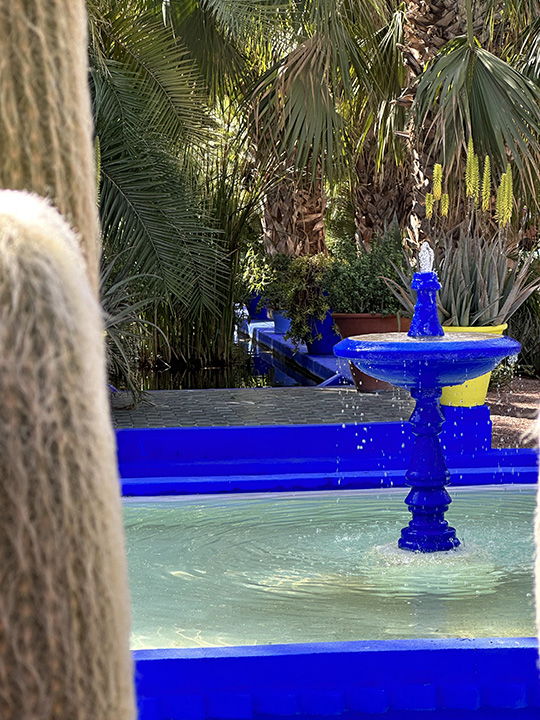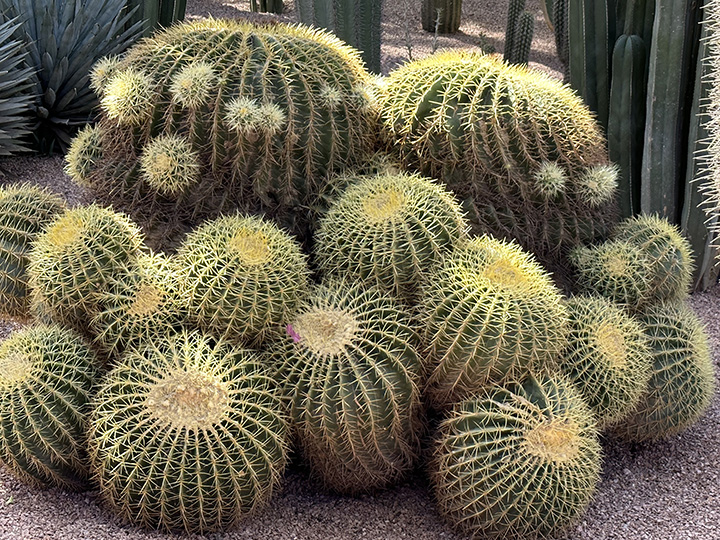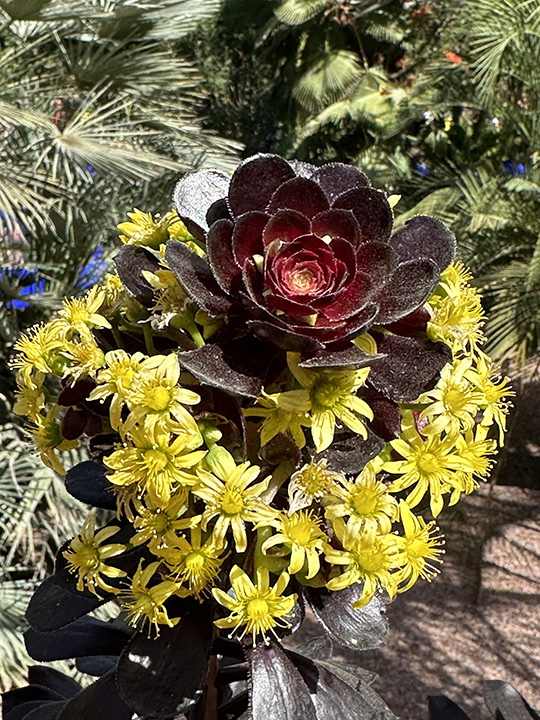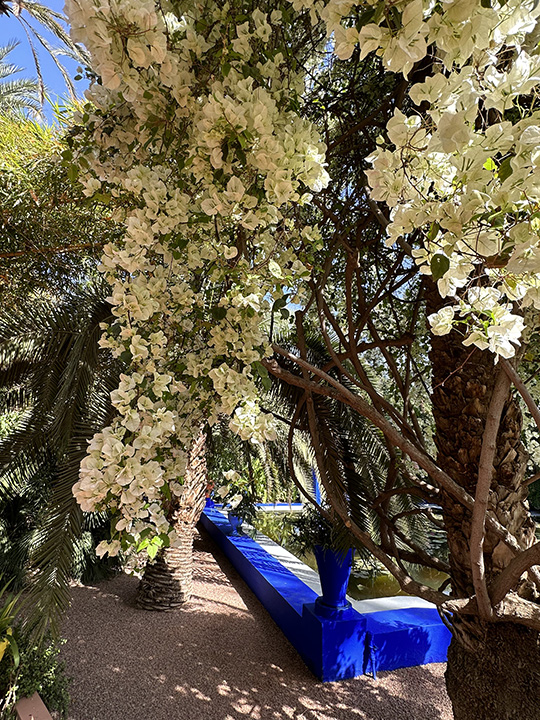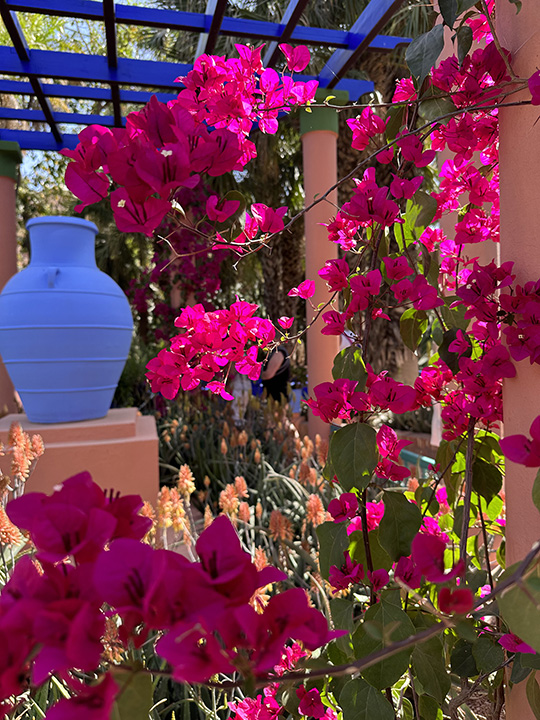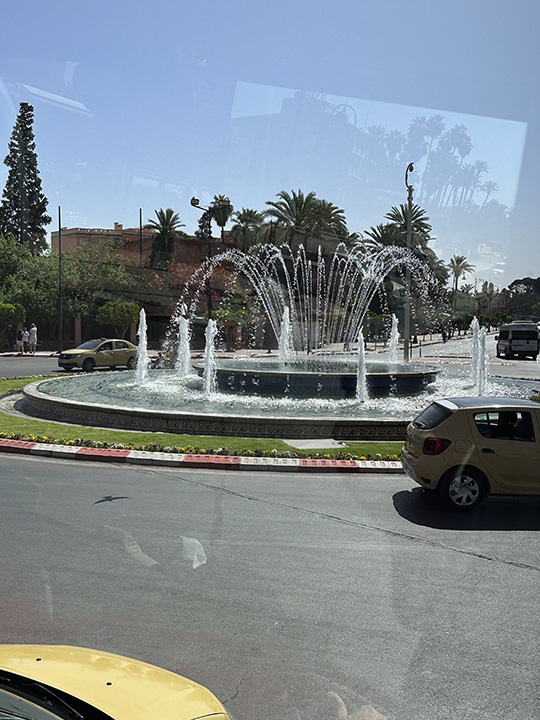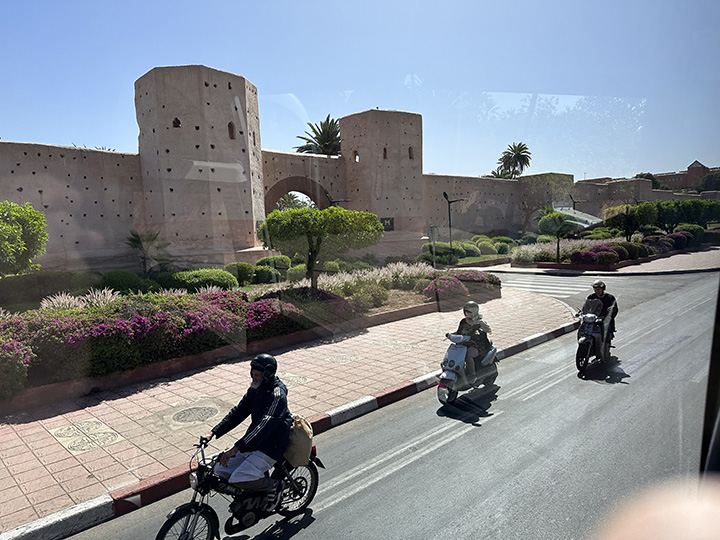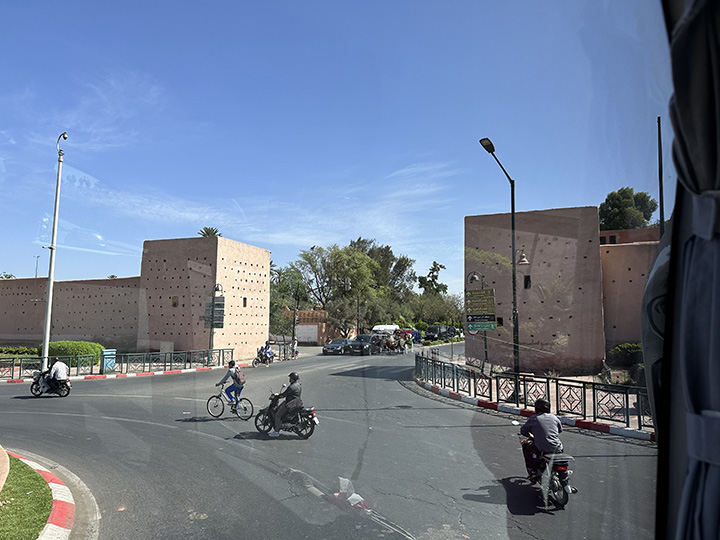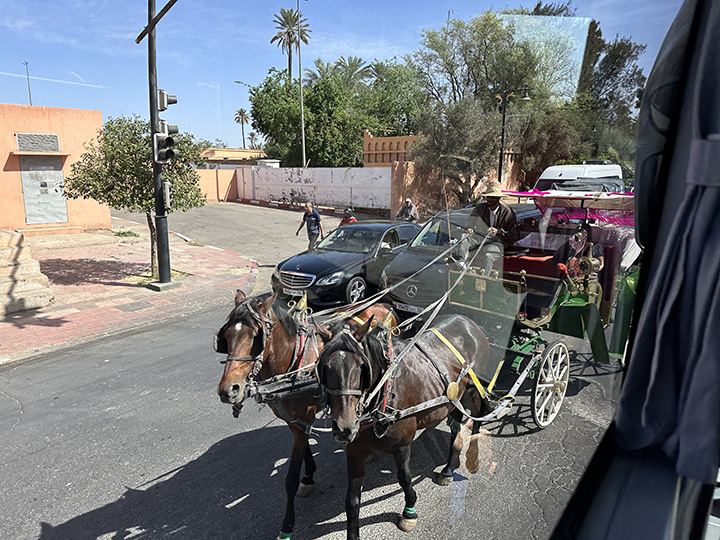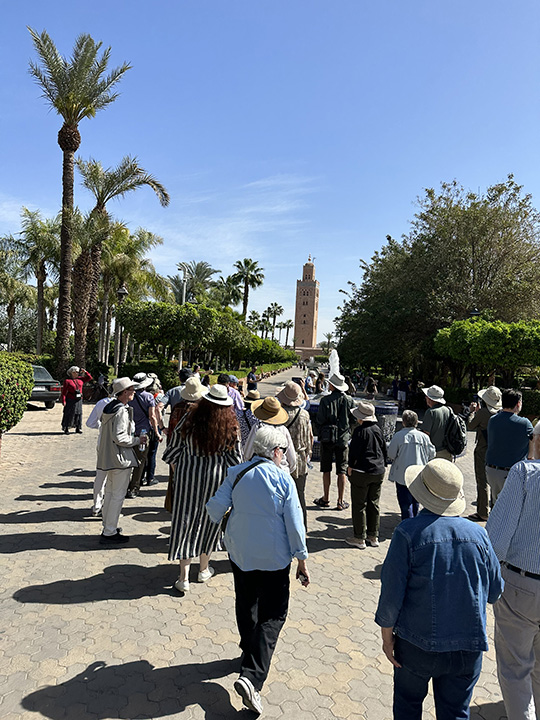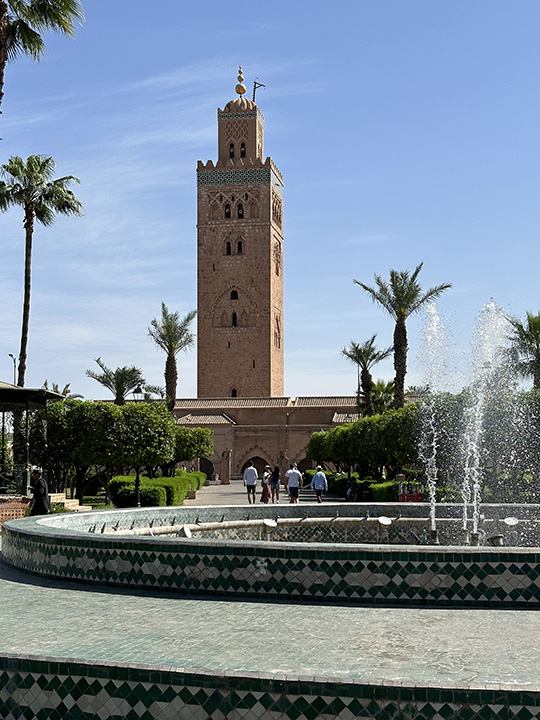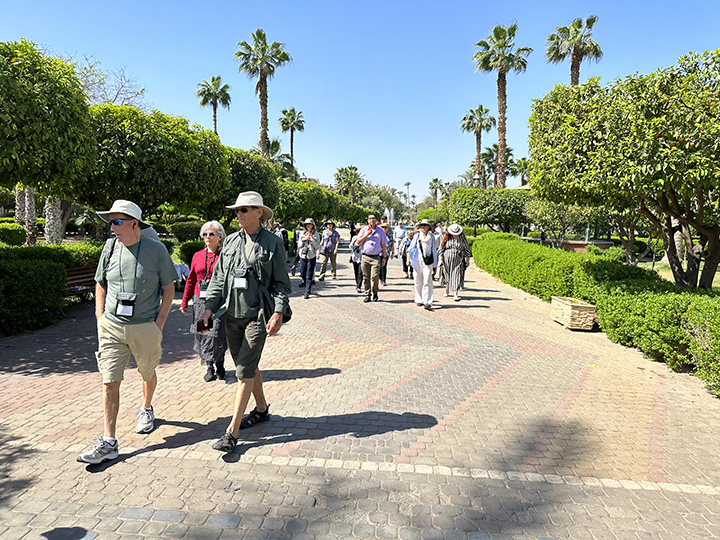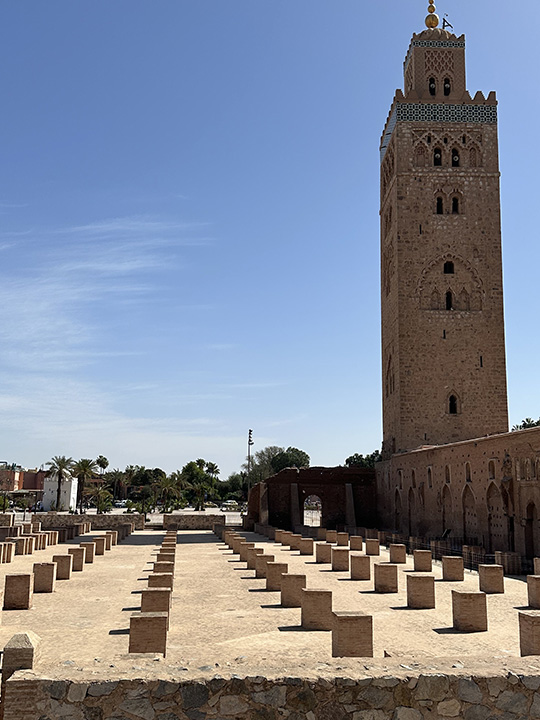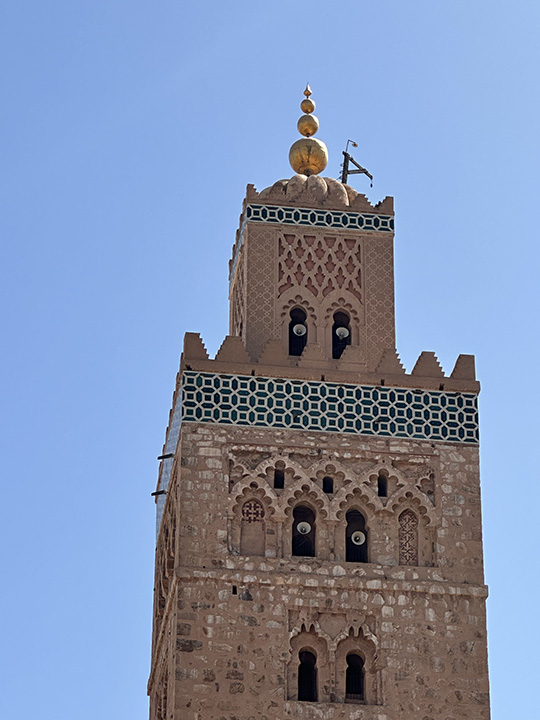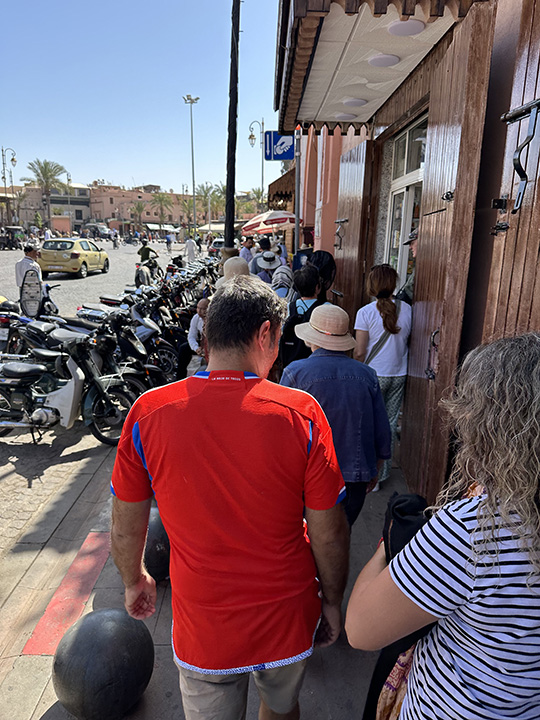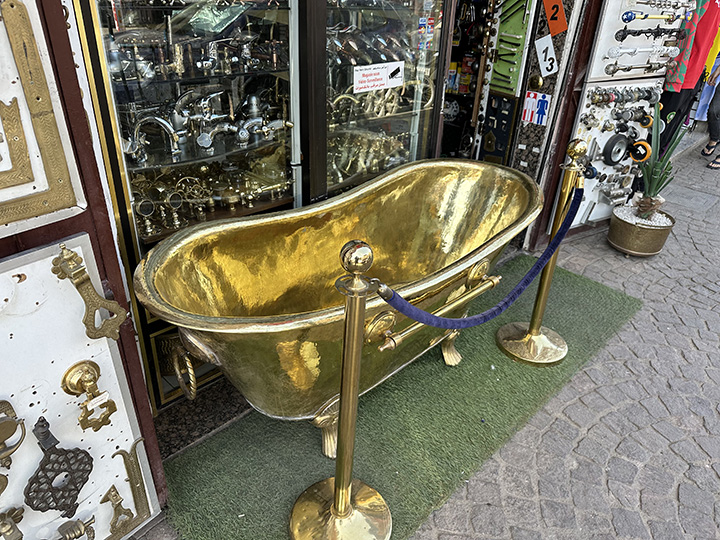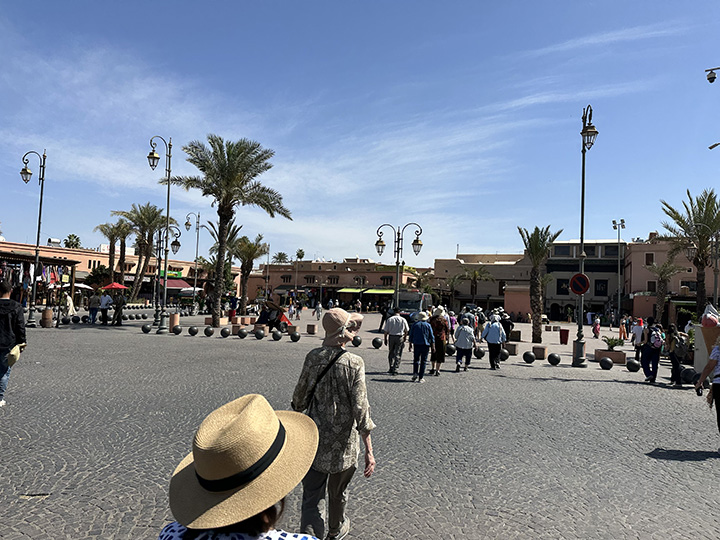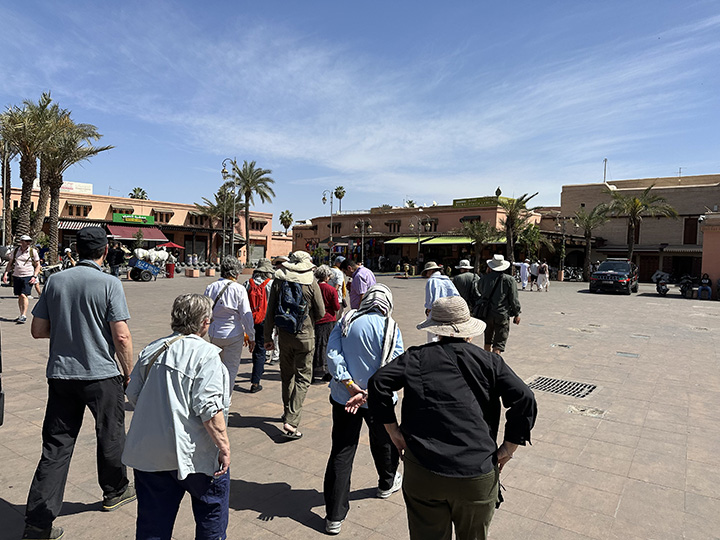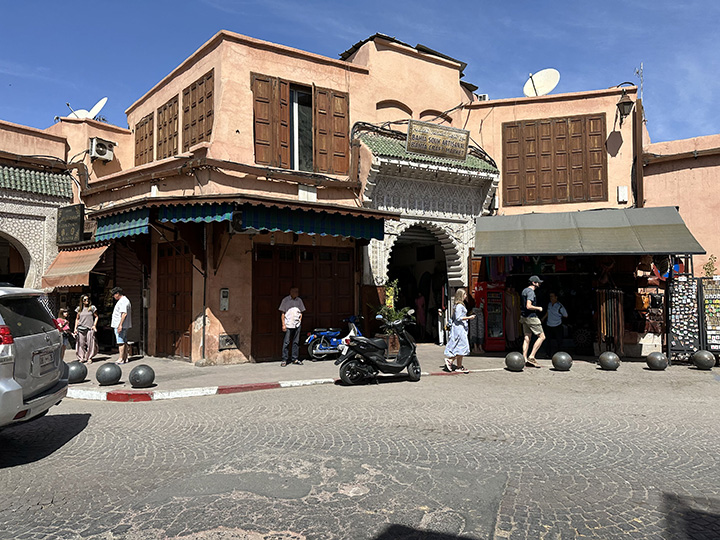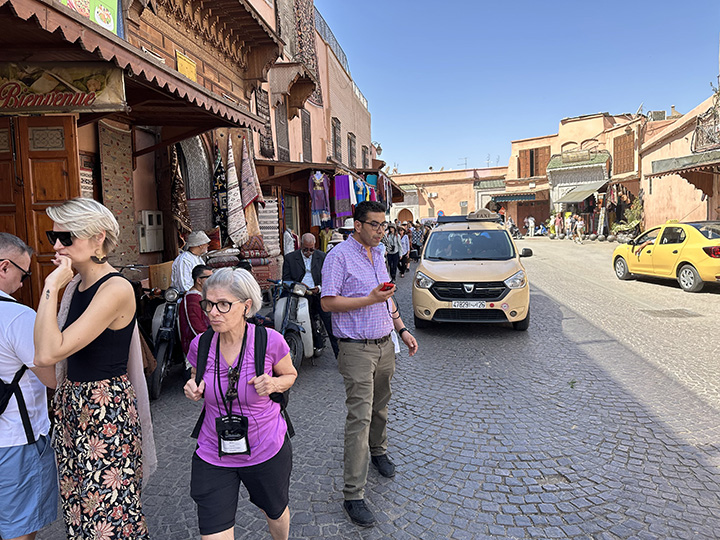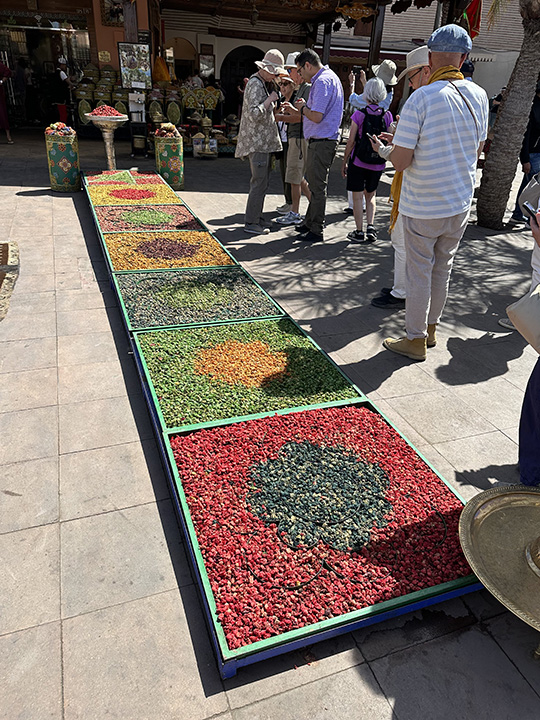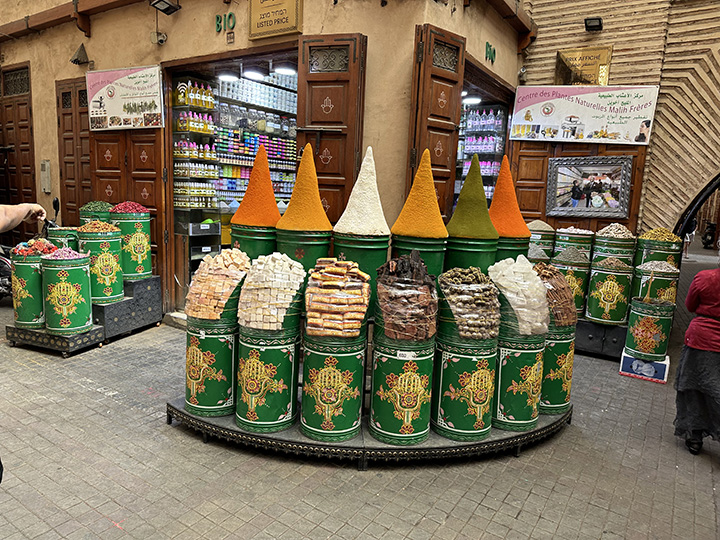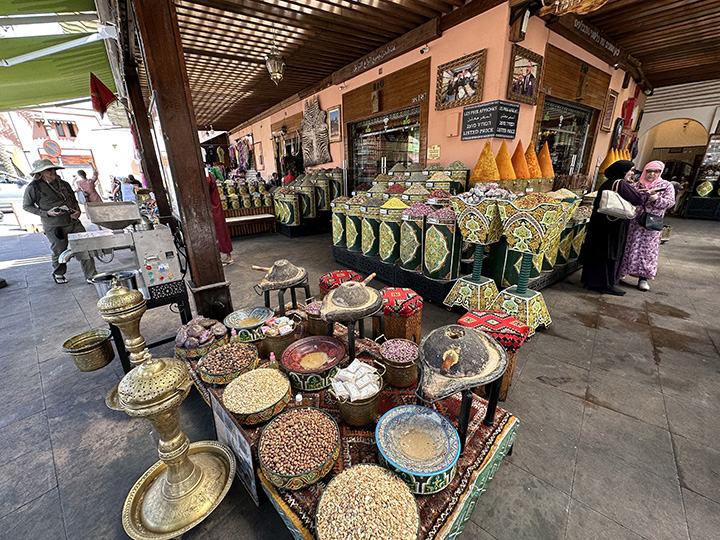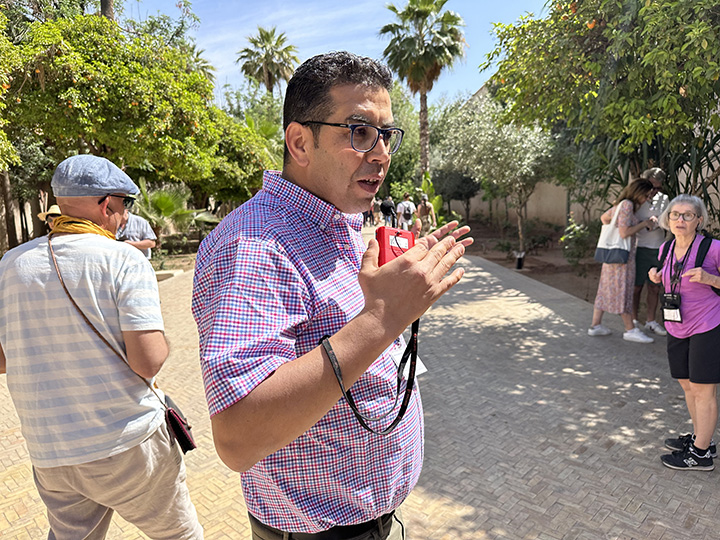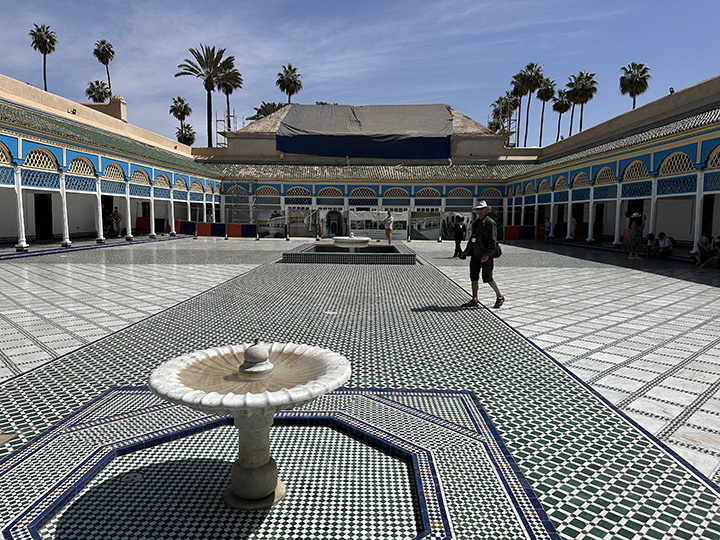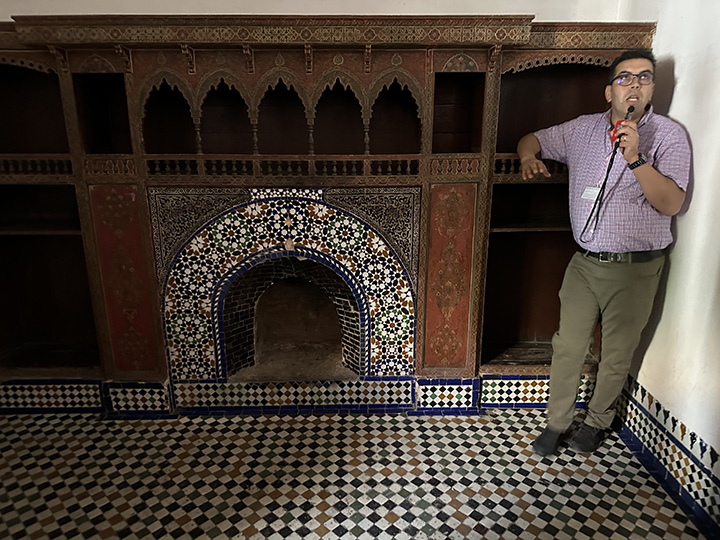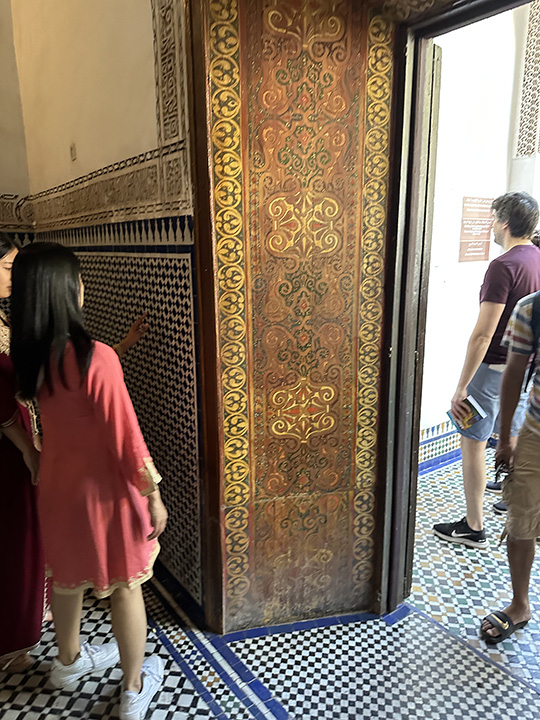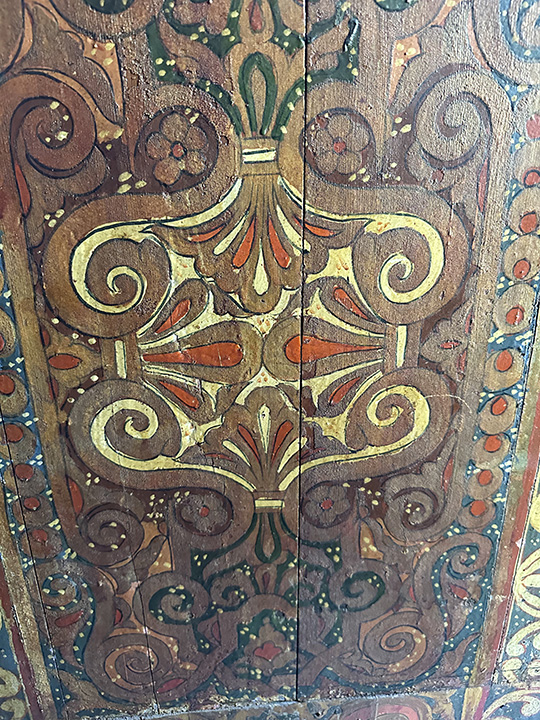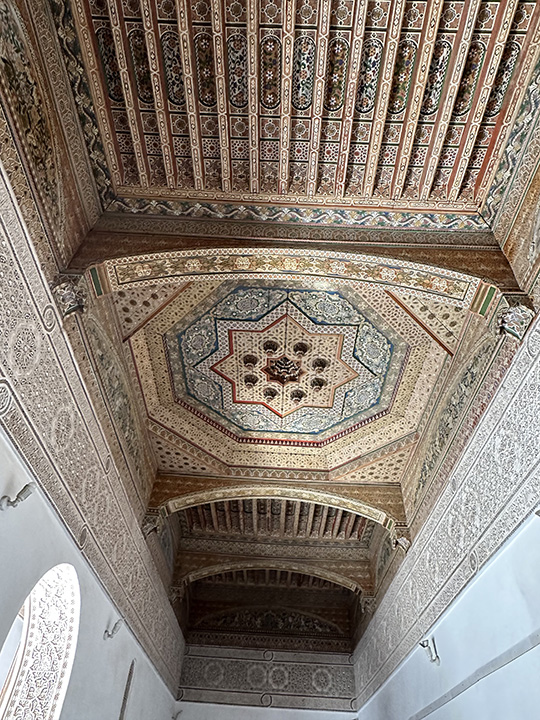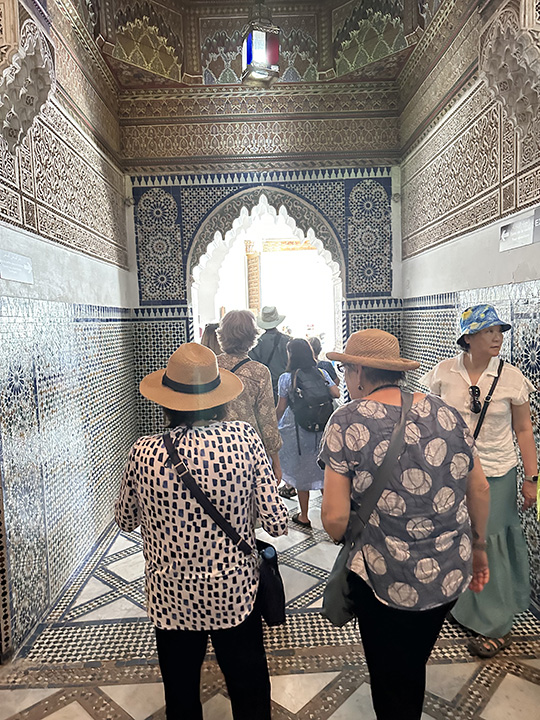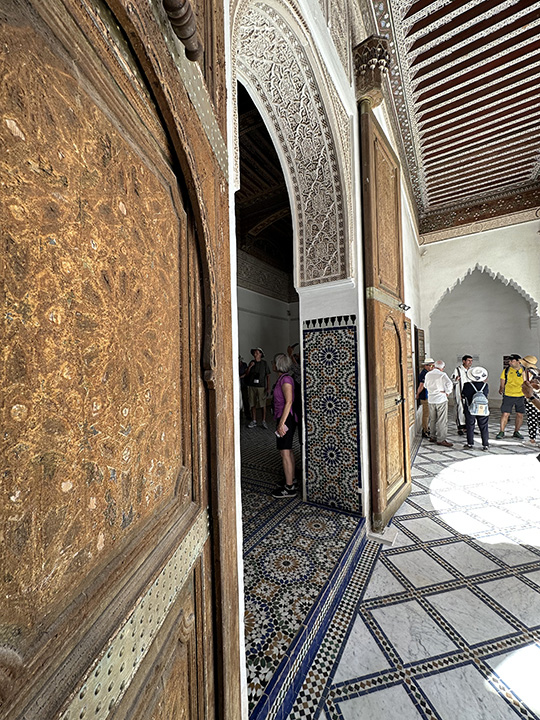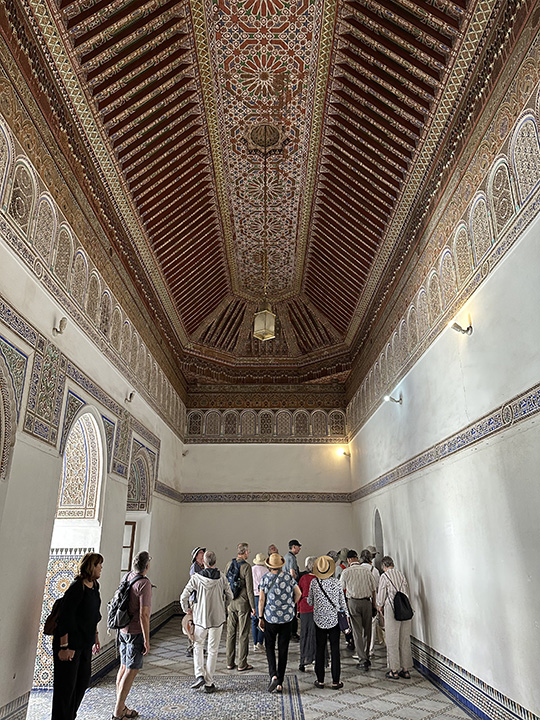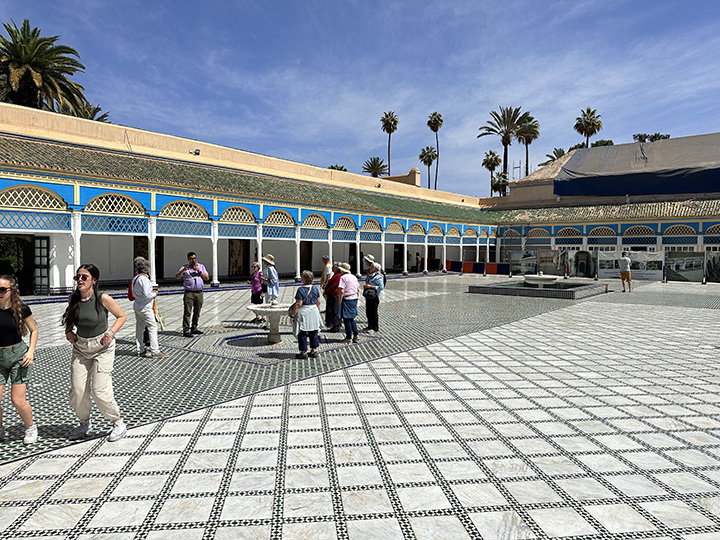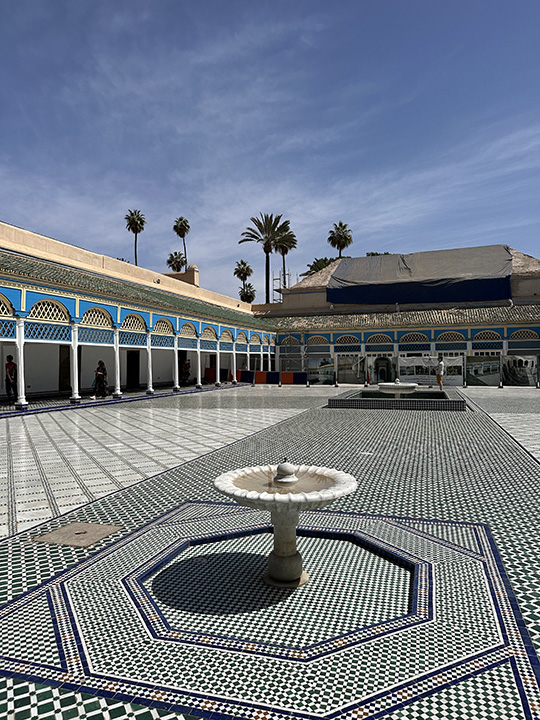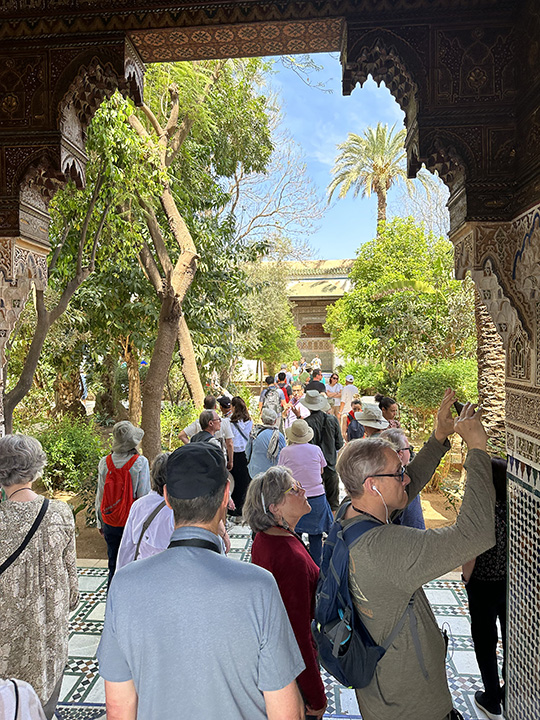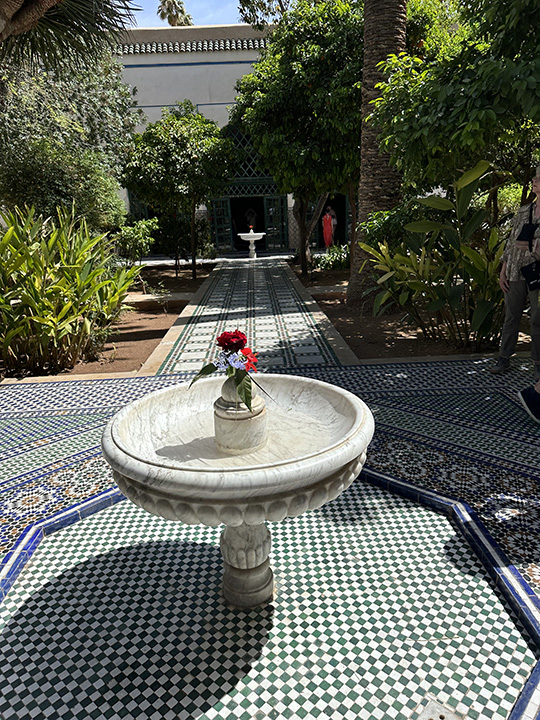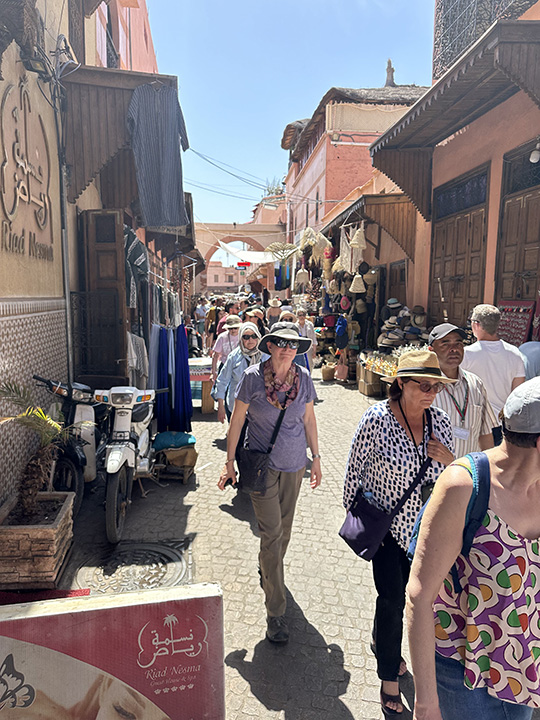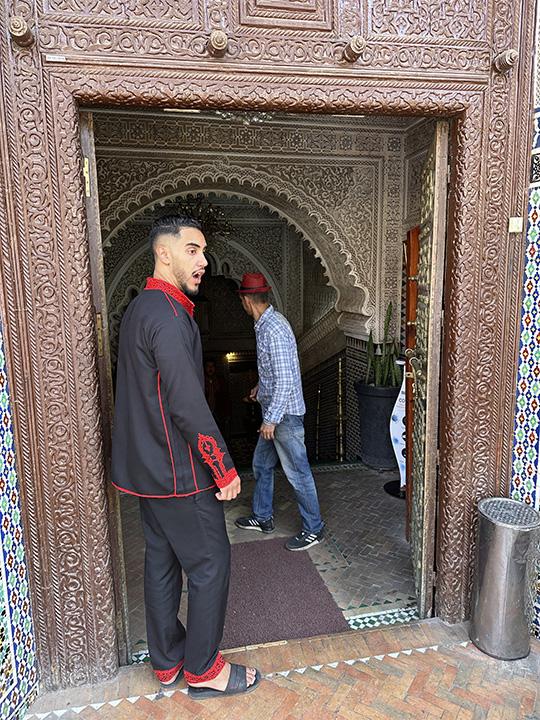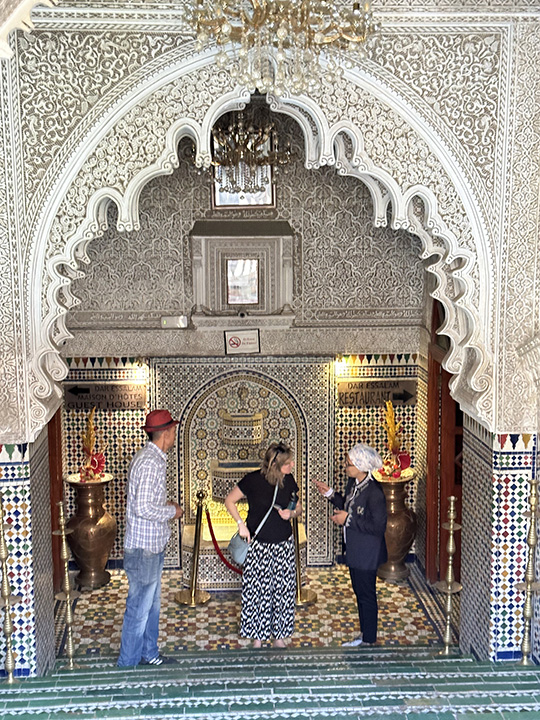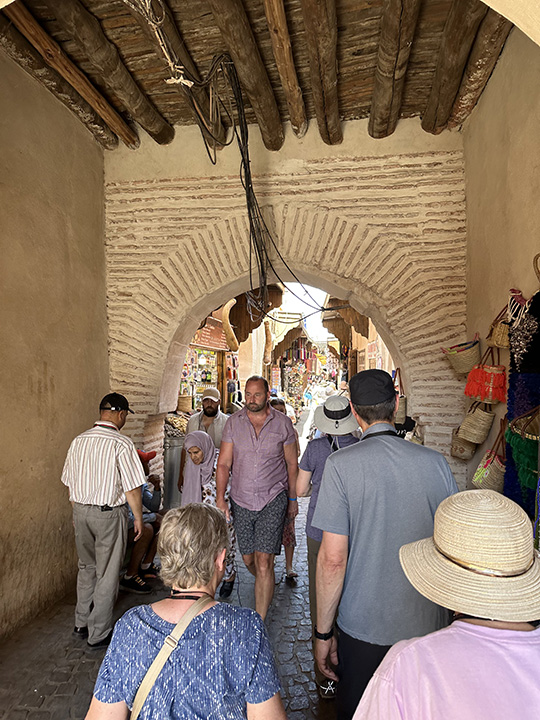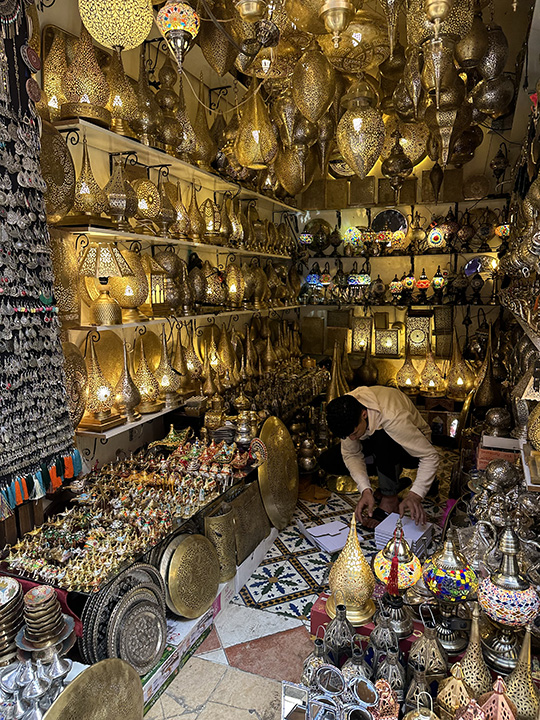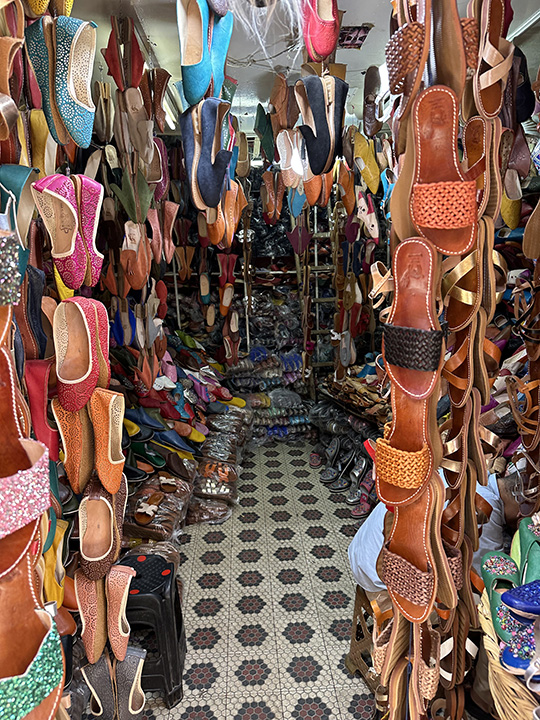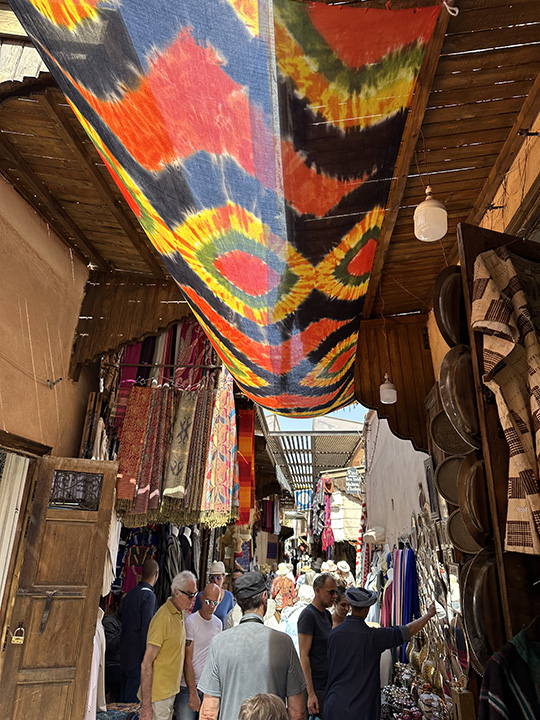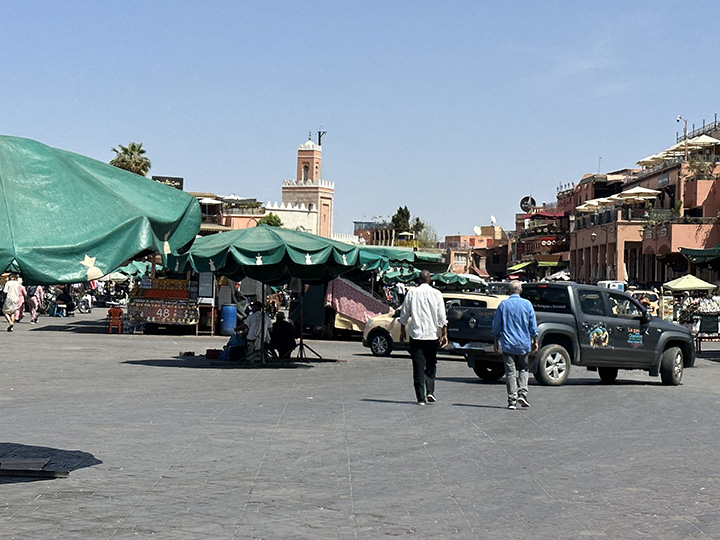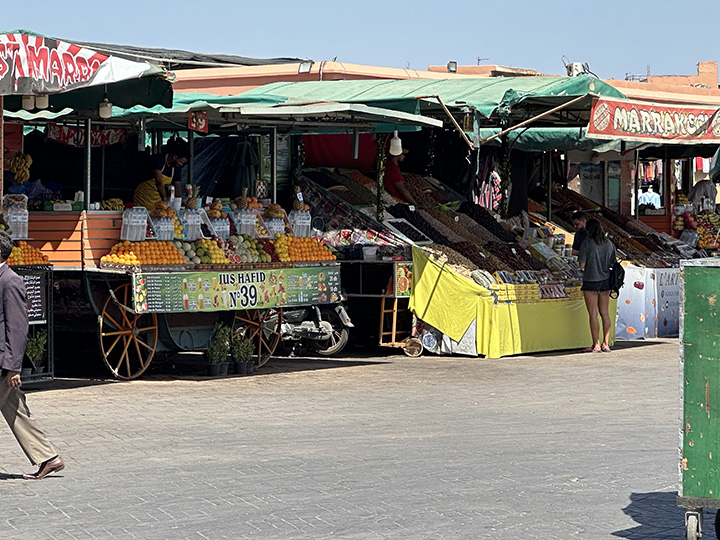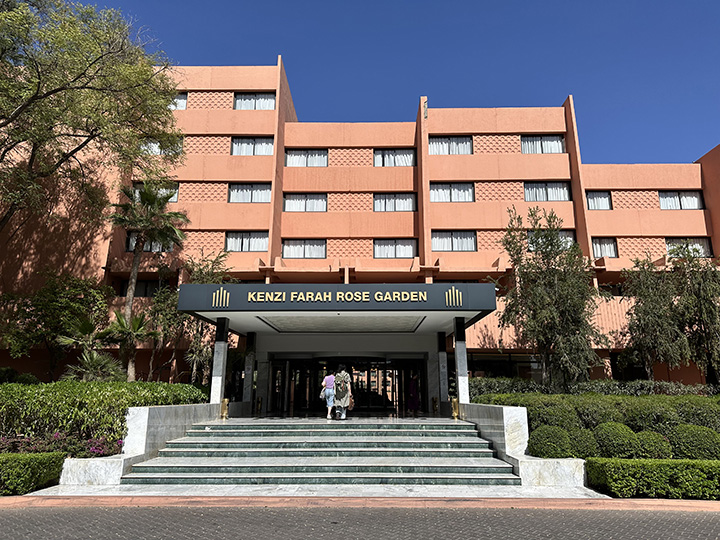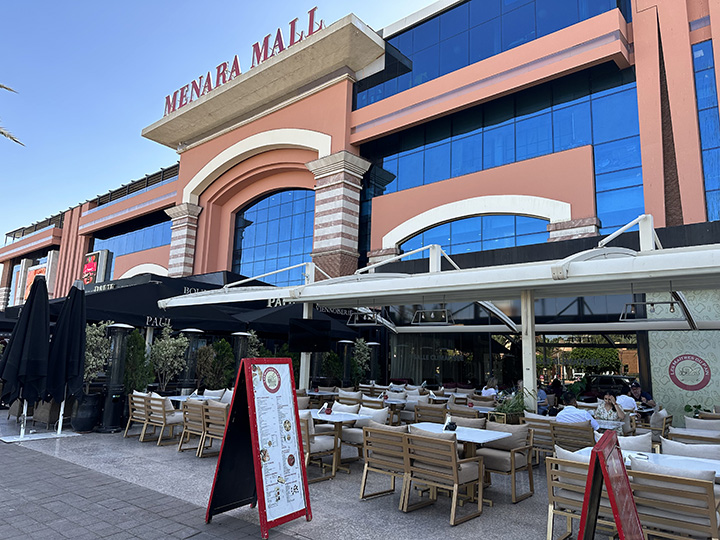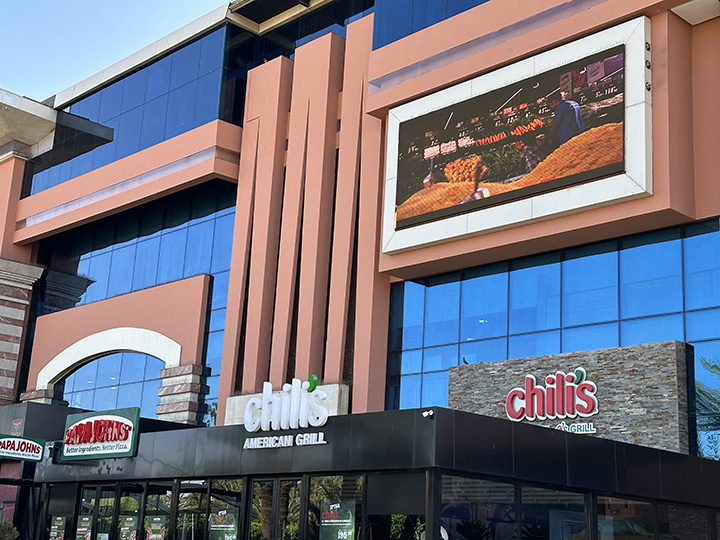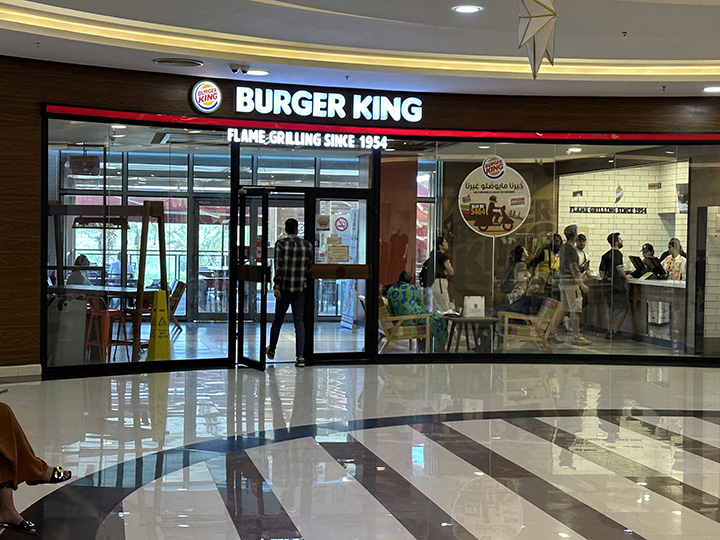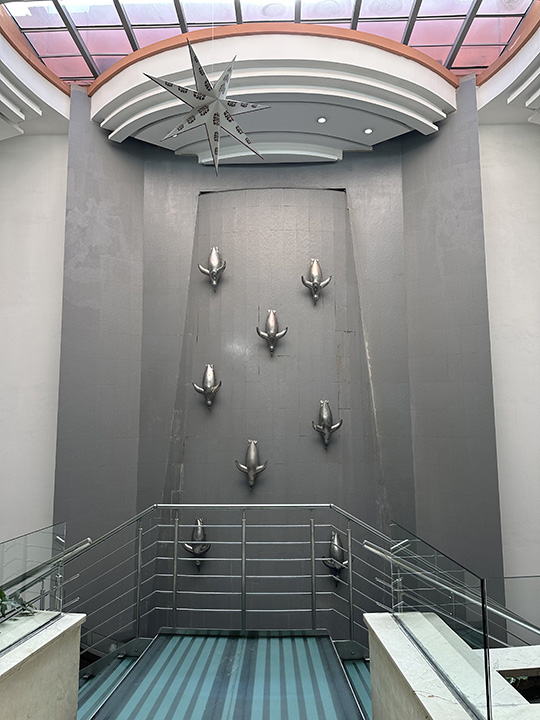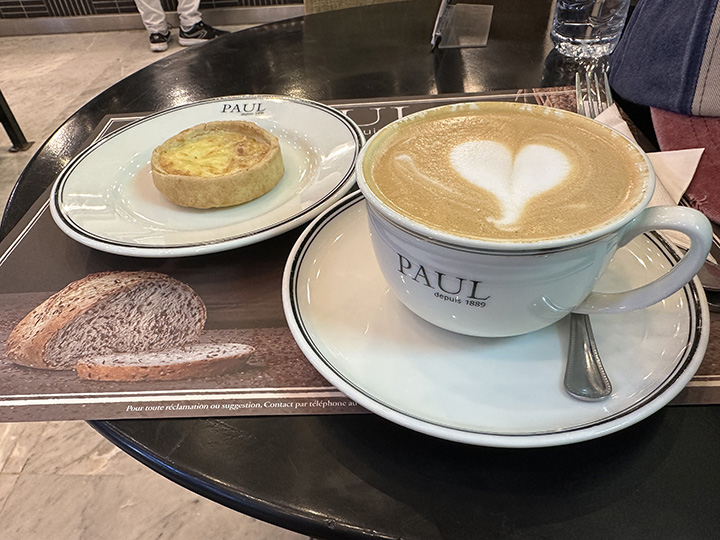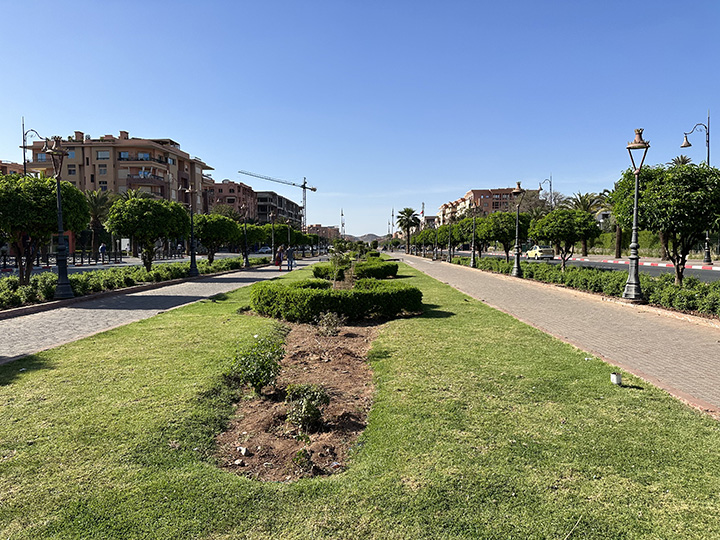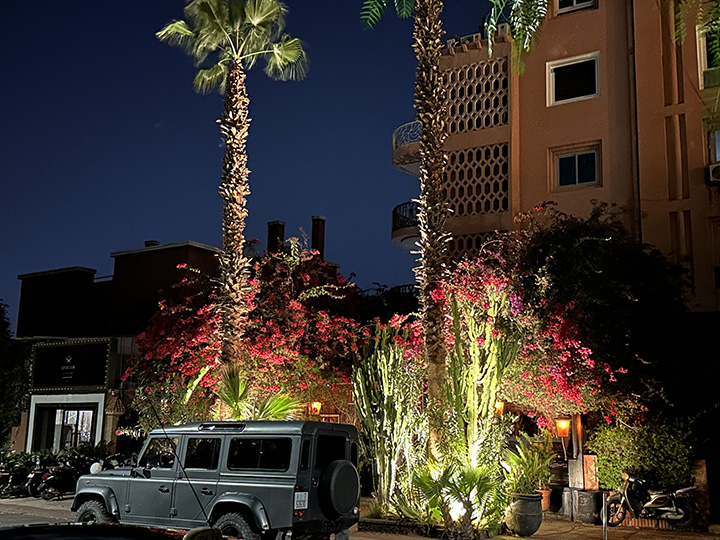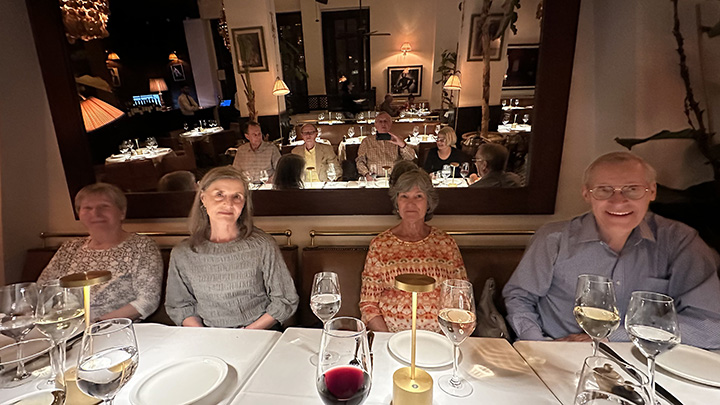|
Today we explored Yves Saint Laurentís garden, toured a palace, walked through the old Marrakesh market area, and even had some time to explore things on our own.
There are guards at the entrance to the hotel.
The front seat of the bus has been reserved for people with motion sickness for most of the trip, but today I got to enjoy sitting up front. I do like a forward view. Thatís a Nabil, our guide. He is telling us all about Marrakesh. He is just an outstanding tour guide, full of information about Morocco and all the things to see here. Plus, heís a great guy.
Want to see him at work? Have a look.
We have arrived at the Jardin
Majorelle. As Nabil explained on the bus, the Majorelle Garden is a
two-acre botanical garden and artist's landscape garden. It was
created by the French Orientalist artist Jacques Majorelle over
almost forty years, starting in 1923, and features a Cubist villa
designed by the French architect, Paul Sinoir in the 1930s. The
property was the residence of the artist and his wife from 1923
until their divorce in the 1950s. In the 1980s, the property was
purchased by the fashion designers, Yves Saint-Laurent and Pierre
Bergť who worked to restore it. Today, the garden and villa complex
is open to the public. The villa houses the Berber Museum and in
2017 the Yves Saint Laurent Museum opened nearby.
There was a gang of tourists buying tickets and lining up to get in, but the Road Scholars already had timed entry arranged in advance. We are special.
Majorelle Garden
As a young aspiring painter, Jacques Majorelle (1886-1962) was sent to Morocco in around 1917 to convalesce from a serious medical condition. After spending a short time in Casablanca, he traveled to Marrakech and like many of his contemporaries, fell in love with the vibrant colors and street life he found there. After traveling around North Africa and the Mediterranean, he eventually decided to settle permanently in Marrakech.
In 1923, just four years after his marriage to Andrťe Longueville, Majorelle purchased a four-acre plot, situated on the border of a palm grove in Marrakech and built a house in the Moroccan style. In 1931, he commissioned the architect, Paul Sinoir, to design a Cubist villa for the property.
And out back he built a garden.
During his lifetime, Majorelle earned a reputation as a celebrated Orientalist painter. The special shade of bold cobalt blue, inspired by the colored tiles he had seen around Marrakech was used extensively in the garden and its buildings and is named after him, bleu MajorelleóMajorelle Blue.
Prior to his death, Majorelle patented the color which carries his name.
It is a striking shade of blue.
And you see it in the garden practically everywhere you look.
There's a nice cactus collection
Kinda spectacular.
Bernie and Bob are enjoying this.
So is Bill.
More cactus.
Gradually, Majorelle purchased additional land, extending his holding by some 10 acres. In the grounds around the residence, Majorelle began planting a luxuriant garden which would become known as the Jardins Majorelle (Majorelle Garden). The garden became his life's work and he devoted himself to developing it for almost forty years.
Pretty remarkable cactus.
Little splotches of color here and there.
Bill is impressed.
The garden proved costly to run and in 1947, Majorelle opened the garden to the public with an admission fee designed to defray the cost of maintenance. At times, he sold off parcels of land to fund the growing garden.
Following his divorce in the 1950s, Majorelle was forced to sell the house and land. After this, the garden was neglected and fell into disrepair.
The garden and villa were rediscovered in the 1980s, by fashion designers, Yves Saint-Laurent and Pierre Bergť who set about restoring it and saving it. The pair owned the villa until 2008.
After Yves Saint Laurent died in 2008 his ashes were scattered in the Majorelle Garden.
Bill is standing in front of the memorial to Yves Saint Laurent who had to travel to France to be cremated after he died because Islamic law wonít allow cremation in Morocco. He is wondering if he is stepping on any of the ashes that were scattered here. He is wondering if the ashes are getting mixed with the Sahara sand dune sand he is still finding in his shoes. You can tell Bill has a lot on his mind.
Beautiful blossoms.
Some of the plants look like works of art.
The purple and yellow make Bill look like a work of art.
Just joking.
Reminds me of a Monet.
That flower is bougainvillea
Bill didn't know what they were called until he looked them up.
He just knew they were pretty.
And now he's a bougainvillea expert.
He's pretty sure that's a cactus, though.
From outer space.
Bill has found an artsy door.
And a blue fountain.
And more cacti.
Are you beginning to think Bill took too many pictures at Jardin Majorelle.
Well, Bill disagrees with you.
Because he couldn't get enough of this place and wasn't ready to leave when it was time to go.
Now let's go visit a palace.
It is inside the Medina, the old city of Marrakesh.
Right through there.
If the tourists want a horse drawn carriage ride, this Medina is just the place.
Now let's go look at the Medina's mosque.
It's easy to spot.
C'mon, Road Scholars, move it along.
The Koutoubia Mosque is the largest
mosque in Marrakesh. It is located in the southwest medina quarter
of Marrakesh, near the famous public place of Jemaa el-Fna, and is
flanked by large gardens.
The minaret tower, 253 ft. in height,
is decorated with varying geometric arch motifs and topped by a
spire and metal orbs. It likely inspired other buildings such as the
Giralda of Seville and the Hassan Tower of Rabat, which were built
shortly after in the same era. The minaret is also considered an
important landmark and symbol of Marrakesh.
Let's go to the old shopping district.
Hey look! Now we know what happened to Donald Trumpís bathtub when he left the White House!
This plaza is often full of people and activity, but remember, itís Ramadan.
It's comparatively deserted today.
There are tourists, though.
Look out behind you, Nabil!
I think there will be spices inside.
Yep. Lots of spices and even a lot of potpourri. This place smells great.
And there are plenty of spices to choose from.
We are about to enter the Bahia palace, and Nabil is telling us all about it.
The Bahia Palace is a mid to late 19th-century palace in Marrakesh, Morocco. The palace was first begun by Si Musa, grand vizier of Alaouite sultan Muhammad ibn Abd al-Rahman, in 1859 and then continued and expanded by his son Si Ba Ahmed ibn Musa, grand vizier of Sultan Moulay Abdelaziz between 1894 and 1900. Today it is a well-known historic monument and tourist attraction in the city.
The tiles and woodworking in the palace are works of art. Nabil is showing us a fireplace.
That's a pretty door.
This is a close-up of the door.
And that is a farback of the ceiling.
Nice place.
But I think I wouldn't want to live here. Back there is the private area where the sultan kept his harem.
I am having trouble picturing a harem in this space. Maybe the ladies liked it.
Real people lived their lives here but now the rooms are just full of tourists. We are running into a lot of tourists today. Itís a situation we really have not encountered before on this tour.
Bill managed to snap a picture of an outdoor area with almost no tourists to be seen. It was a miracle.
Because they were everywhere.
It was a fine palace. Now let's go to the market.
Anne and Maggie seem unready to shop.
In there is a restaurant.
Nabil says Alfred Hitchcock filmed scenes for "The Man Who Knew Too Much" in there.
Lotsa tourists are exploring the market.
This place is full of stuff I donít want to buy.
See what I mean? I wonder how many cows gave their lives for the shop.
Whatever you think about the goods for sale, you have to admit the place is colorful.
Now back to the main square where the sound of snake charmers playing the pungi fill the air. I'd have taken pictures, but they want money for that and I didn't need pictures that badly.
Really, honest, I promise I was just innocently shooting a 360į video of the market square when I accidentally caught a couple of ladies ijn their hijabs and apparently if there's anything ladies in hajibs don't like it's being photographed by tourists. Just look at them scatter. I'm sorry. I didn't mean to. If you listen carefully you may hear the sound of a pungi playing snake charmer.
Gotta leave the market.
Back to the hotel.
And then Bill took a little afternoon walk all by himself over to the local Menara shopping mall.
They had a Papa John's and a Chili's.
Even a Burger King.
And a fancy multi-story indoor fountain that doesn't even hardly look wet in this picture.
Just down the street from my old condo in DC there was a Paul coffee/sandwich shop. So I had a cuppa and a quichelet just for old times' sake.
Then I made my way back to the hotel. I am Standing in a pedestrian park that forms a median for the very broad Mohammed VI Avenue. There is actually lots of traffic on the extreme left and right of the picture, but apparently I snapped the photo when there was a break in the traffic.
Tonight eight of us had dinner at a very nice French restaurant called ďThe Palace.Ē it was about a 15 minute walk from our hotel.
We had a wonderful meal. No tagine to be seen. There were eight of us and I tried to get everybody crowded into one shot. See the other four Road Scholars in the mirror? L-R rear are Ross, Don, Bill and Laura. L-R front are Anne, Sarah, Anne and Tom.
|

